

From the PBC Vault: Catamarans vs V-Hulls
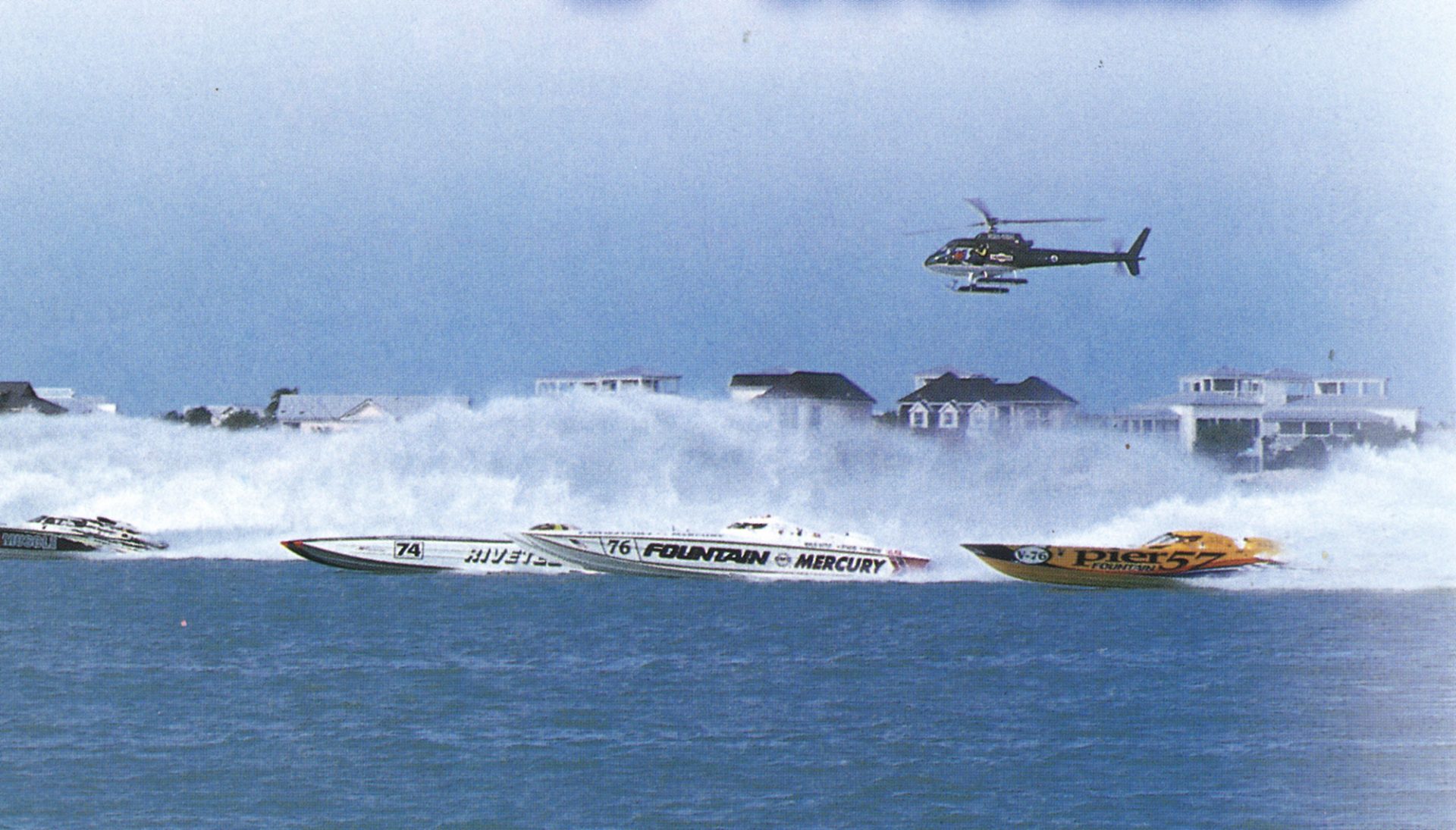
Wherein lies the difference?
By Steve Bandler
Poker Runs America / P ower Boating Canada has received a number of letters asking about the differences between catamarans and V-hulls. This is in response to those letters. For our readership, we will address only planing catamarans, primarily for high performance, in the 20- to 50- foot length range, although most of the discussion applies to all cats.
Design and Performance Considerations
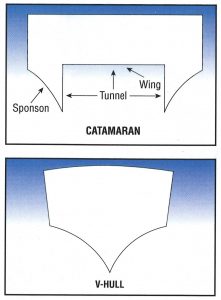
The underside of the supporting structure is referred to as the wing. Originally, cats were designed to improve a boats lateral stability. At low speeds, the cat provides a platform in the water analogous to a person standing on two feet as opposed to one foot for the V-hull. This reduces the tilting that occurs when a boat is loaded off its centerline.
As speed increases, a planing hull rises in the water. A V-hull has to balance on its V as the wetted area narrows. When the wetted area becomes sufficiently narrow, wind and water disturbances, and steering input can result in chine walking, a lateral instability where a V-hull rocks back and forth from side to side. As speeds increase, chine-walking amplitudes can increase to dangerous levels.
Deep-V’s, popular in offshore applications to provide a softer ride in rough water, are more prone to this condition than flatter bottomed boats. The catamaran, with its wider stance, provides a solution to this problem. The cat’s sponsons can be sharpened along their keels to reduce slamming in rough water while still providing a running platform.
As more powerful engines have been produced, speeds have increased to the point where aerodynamic forces have become significant. The wing like supporting structure between the hulls of a cat can be shaped to provide aerodynamic life.
Since water is more than 800 times as dense as air, using a cat’s wing to generate lift, and reduce water area on the boat, improves life to drag ratios significantly as compared to a V-hull. This makes cats of similar size, weight and power faster than V-hulls.
Designing a cat to properly account for the aerodynamic and hydrodynamic forces is not easy. Correct location of the centers of both aerodynamic and hydrodynamic forces is essential to providing a safe and stable ride. If the center of an aerodynamic force is too far forward, a cat can blow over if the angle of attack is too great when launching off a wave.
Also, if insufficient aerodynamic lift is generated, waves can impact the wing, an effect know as tunnel slap, resulting in excessive slamming in rough conditions. Such design deficiencies kept early high-speed cats from running as fast as V-hulls in rough water and they were considered smooth water boats. Today, with improved designs, cats will typically outrun similarly sized V-hulls in all but the roughest conditions. The air compressed under the tunnel cushions the ride.
Handling Considerations
When considering handling characteristics, it is important to remember that cats typically run faster than their V-hull counterparts. Higher speeds alone result in handling differences. That being said, a well-designed cat tends to provide a more stable and secure ride than a similarly sized V-hull at the same speed.
Other than speed, the greatest difference that I’ve found between cats and V-hulls is in turning, especially at high speeds. When rudders or outdrives are deflected to turn a boat, a momentum, or torque is generated that cause the boat to rotate about its longitudinal axis and lean into the turn.
With its narrow stance in the water, a V-hull will lean deeply into the turn allowing its bottom surfaces to deflect water away from the turn to ate forces that will counter the centrifugal forces. This allows a V-hull to carve a tight turn with little skidding. With its wide stance, a cat cannot lean as deeply into the turn.
This results in smaller hydrodynamic forces to counter the centrifugal force so that the cat tends to skid around the turn. Advancing the outboard throttle slightly in a twin-engine cat can help improve turning, but care must be taken not to over-steer or the cat will spin out or catch a sponson and flip over.
This is not to say that the same problems can’t be encountered by a V-hull. It’s just that a cat is more sensitive to them. As with any boat, seat time is important before taking a boat near its limits.
In choppy water, at idle and very low speeds, water displaced in the tunnel between a cat’s sponsons may not be able to exit at the transom if the aft section of the wing is submerged.
This water is forced forward and can exit the tunnel at the bow in an upwards direction. If this water comes up over the bow it can result in a wet ride. A V-hull deflects water to its sides eliminating this condition.
Needless to say, in very windy conditions with heavy seas, neither hull is immune to a wet ride. Due to the greater distance between propellers in a twin-engine cat than a high-performance V-hull, the cat will outmaneuver its V-hull counterpart around the docks.
The greater the propeller distance from the centerline of the boat, the great the turning moment. This makes it easier to turn the cat in a shorter distance than a V-hull. The turning effect of placing one drive in forward and the other in reverse is greatly enhanced.
Accommodations
The requirement for larger wings to increase aerodynamic lift in high performance cats gives rise to cats that are typically wider than similarly sized V-hulls. Therefore, cats usually have more available deck space than similarly sized V-hulls.
On the other hand, the cats tunnel takes away from the potentially available cabin space. It’s unusual to see standing headroom in a high-performance cat. Catamaran cabin designs typically provide headroom in the sponsons and use the section over the wing for tables and berths while V-hull designs plan for maximum headroom along a center aisle.
Structural requirements and design complexities tend to make catamaran hulls more expensive than similarly sized and outfitted V-hulls. However, a cat will generally be more efficient to operate than a V-hull at the same speed, thereby saving fuel costs. Also, some of the higher costs of the hull can be recovered in engine and drive package savings since a cat can run as fast as a V-hull with less power.
Cats versus Vees: A Racer’s Point of view
By Michelle May Schmidt
Driver – Don Q Cristal, 2000 APBA offshore Super Cat National Champions, APBA Half of Champions
Patel is a heavyweight in the offshore arena. He has also owned and races cats and Vees.
“In super rough water, Vee bottoms cut through better and vision is better. To me, it’s safer to race a Vee hull”
Patel feels that catamaran hulls sporting twin canopies can produce a negative effect towards vision.
“It becomes difficult when you try to make a left-handed turn. You get a skewed view and have to look through the throttleman to make the turn safely.”
That, says Patel, combined with the higher potential to turn a cat over, would be two facts to consider when looking at racing a cat hull.
And he should know, since he blew one over at 150+ miles per hour a few years ago in testing. That in mind, Patel still prefers the stability in the width of a cat when turning in rough water.
Suggestions for non-racers wanting to wear the uniform in pursuit of the checkered flag? “Start off in Factory Class. It’s the cheapest, safest and most dependable to run in. and know your limits. Don’t run over your head and get hurt.”
Steve David
OPBRA vice president, former APBA president, former driver – Citgo Supergard, Unlimited Hydro Champion.
David points out that Vees are highly exciting because at top end they are on the edge and require very little lateral stability. They’re super reactive to drive, tab and wave action.
According to him, a smaller Vee hull can take larger seas than an equivalent cat, although that equalizes as you get into the 40+ foot range. In addition, a Vee can run through exceptionally rough head, quartering and following seas while maintaining pretty good headway.
“The flip side,” says David, “is that it takes a lot of power to get a vee hull over 100 mph and then huge incremental horsepower gains to exceed 120 mph, whereas the equivalent horsepower in a cat would yield another 20 mph.”
David admits cats can run quick without massive horsepower and have excellent turning characteristics, but he feels it’s a rough and wet ride until you get into the larger ones.
“I wouldn’t say it’s a negative, but more of an observation that the larger cats have a reduced utility in terms of everyday use, because of the width for trailering or dry storage.”
David wants those not yet involved in offshore racing to know that the same courtesy that exists in everyday boating exists in racing as well.
“Whether one is a pleasure boater meeting new friends at a distant marina or anchorage, or a new offshore racer, boating is a family activity in a much larger sense.
It’s a shared experience of exploring, the freedom to roam and virtually no limit to your travel desires. Boating, including offshore racing is an exclamation point to our daily lives!”
John M. Kiely
Owner/throttle-man – Kiely Motorsports/Team Tellium, Factory 3, 2nd Place National and Worlds, raced in early 1990s
John Kiely runs a skater and feels that the efficient hull design of the catamaran allows for a high top end speed without the need for big, expensive power. He adds that the distance between drives allows him to maneuver around docks and other boats without too much effort.
“The downside to cats is that there is limited salon area on the pleasure boat applications, but the upside is that my twin ABPA 502 EFI Mercs accelerate my 36 Skater well over 100 mph on pump gas.”
Kiely says that Vee bottoms ‘have it made” in the public’s eye, because they automatically view the hull as THE original shape of offshore high performance, due in part to the fact that many legends in the sport started with a deep Vee. “However, the public also seems to have a misconception about cats in reference to their stability in rough water,” he adds, in support of the cat.
As for the pro side to Vees, Kiley feels that it is far more practical to haul a Vee bottom citing that it is not uncommon for a 45-foot deep Vee to have a beam of 8’6” or less.
As for performance, the downside, in Kiely’s opinion, is that some deep Vees have a nasty habit of chine walking. To him, this characteristic is uncomfortable at any speed. It also takes a large financial and labor-intensive effort to obtain speeds in excess of 100 mph in a Vee bottom.
“To anyone not involved but interested in racing I offer these words of advice. The positives of cats and Vees can be enhanced, and the negatives can be diminished as long as you’re a team.”
Peter Doerner
Owner/throttleman – Freedom Offshore Racing, F-1, 1999 National and World Champions
In a racing situation, Doerner will tell you that the deep Vee hull is much faster and more agile in the corners than a cat. It’s also an outstanding rough water hull.
He will also add that the V-hull needs to break contact with the water to gain the maximum speed this design will allow.
Doerner finds that the current step designs in some V-hulls tend to be squirrely around flat water corners in.
High-speed situation whereas the wide design of a catamaran hull allows for an air entrapment that gives it more stability in average conditions.
“The positive lift design of an air entrapment hull will produce more speed, given like horsepower, than a Vee hull design,” say Doerner. “However, it does take longer to get on plane for a cat, given the same horsepower, than a Vee hull.”
Doerner’s advice for those who are not already involved in offshore racing is to come to a race, meet the teams, look at the equipment, bring their families, and “catch the fever that the next great motorsport is fueling all over the country!”
David Woods
Owner/throttleman, Pier 57 Fountain fleet
Woods had surely gotten more run for the money than any offshore racer out there this past season, via advertising on his fleet, ever-growing Vee bottoms.
His stable includes Fountain USA.com, Pier 57 Fountain, Fountain Pier 57, and Utz Pier 57 Fountain, racing in the Super Vee, Vee Lite, and Factory Classes.
Woods’ first comment out of the box was Vees are way too cool. To which Art Lilly, his partner in offshore adds, “They are long lean, fighting machines.”
As an afterthought, Woods states: “I sell Vees. I race what I sell. And, I like Reggie.”
Woods does admit that cat hulls go fast with little horsepower whereas it takes more horsepower to get a Vee-bottom going. Another cat positive? “There is no drag in flat water where the Vee has more boat in the water. But lets face it, cats have training wheels,” he jokes with Lilly. “Art’s raced both.”
Woods does concede that Vees are more difficult to race at higher speeds. “It’s basically a balancing act,” he says, compared to running a cat hull. “You don’t run a cat like a boat, you fly it like an airplane.”
Related Post
Don’t abandon your boat. keep our waters safe, tiara yachts expands ls line with largest outboard model to date, the 56 ls, wajer yachts unveils the wajer 44 s in ibiza.
- 2024 BOAT BUYERS GUIDE
- Email Newsletters
- Boat of the Year
- 2024 Freshwater Boat and Gear Buyers Guide
- 2024 Boat Buyers Guide
- 2024 Water Sports Boat Buyers Guide
- 2024 Pontoon Boat Buyers Guide
- Cruising Boats
- Pontoon Boats
- Fishing Boats
- Personal Watercraft
- Water Sports
- Boat Walkthroughs
- What To Look For
- Watersports Favorites Spring 2022
- Boating Lab
- Boating Safety
- Ultimate Boating Giveaway

Catamaran Versus Deep-V Monohull
- By Chris Caswell
- Updated: February 26, 2018
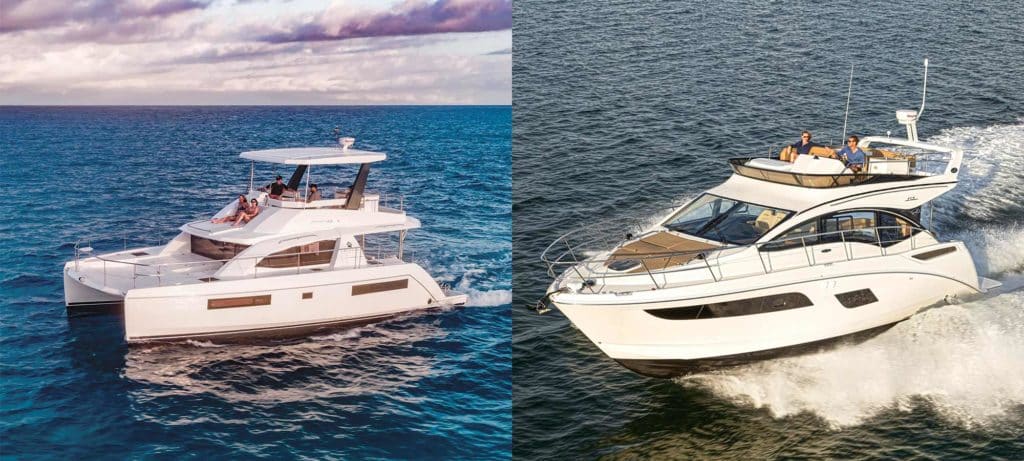
Ever since the Polynesians started crossing oceans on catamarans when much of the “civilized” world was still afraid of the sea, the idea of the twin hull has ebbed and flowed in popularity. For centuries in the Western world, the monohull ruled the seas. At least until 1876, when Nathanael Herreshoff designed a sailing catamaran that was so fast, cats were actually banned from racing for years. Yes, cats are cool. But how do they really stack up against the classic, tried-and-true deep-V monohull?
Let’s look at the strengths and weaknesses of catamaran and monohull boats. We picked two boats of similar length: the Sea Ray Fly 400 (43 feet 6 inches) and the Leopard 43 Power Cat (42 feet 8 inches). The Sea Ray displaces more (30,900 pounds versus 25,794 pounds), but the major difference is beam: The Leopard, carrying 22 feet 1 inch of beam, is nearly 9 feet wider than the Sea Ray (13 feet 6 inches). And that is where many differences between the two start.
Before we go on, we need to provide a disclaimer. We know we’re comparing apples to oranges to some degree, so don’t go sending us angry letters about an unfair comparison. Frankly, it’s sometimes good to compare the taste of oranges and apples. And here’s the thing: We like them both! Both boats ended up with good scores in some areas, lesser in others. We do believe that the concepts that surfaced as a result of comparing these two boats will help cruiser buyers make a more informed decision if the question of cat versus mono arises in their quest for a new boat. That said, let the comparison begin.
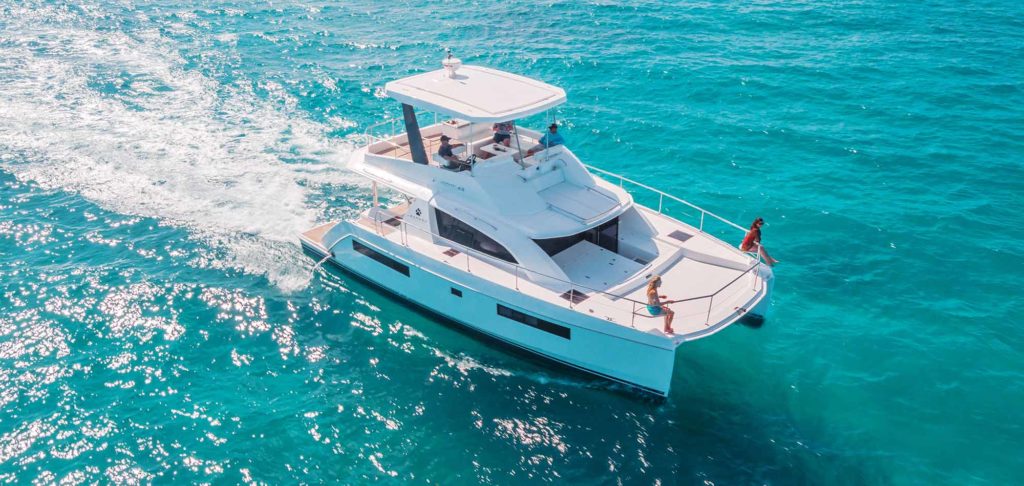
Fast Action: Speed Vs. Efficiency
With 960 hp from twin Cummins diesels, the Sea Ray easily wins in top speed at nearly 34.5 mph compared to the Leopard (27.6 mph), but at a serious cost in fuel. At 20 mph, the Leopard is using just 20 gph, for an even 1 mpg. At the same speed, the Sea Ray is using 32.6 gph, netting 0.5 mpg.
“A strength of the catamaran is that it has such low drag,” says Gino Morelli, the catamaran designer, whose credits range from America’s Cup contenders and Olympic-class cats through power cats for charter use up to a record-setting round-the-world 125-foot cat. “It’s just basic hydrodynamics: Two slim hulls have very low resistance. They push much less water than one wider hull and therefore require smaller engines for increased efficiency.”
The Sea Ray is faster; the Leopard is more efficient. It’s nice to have speed when you want to outrun an approaching squall or get to an anchorage first. On the other hand, you’ll probably spend most of your cruising time at the lower speed more comfortable to your guests.
Our take: Both are winners. It’s your choice.
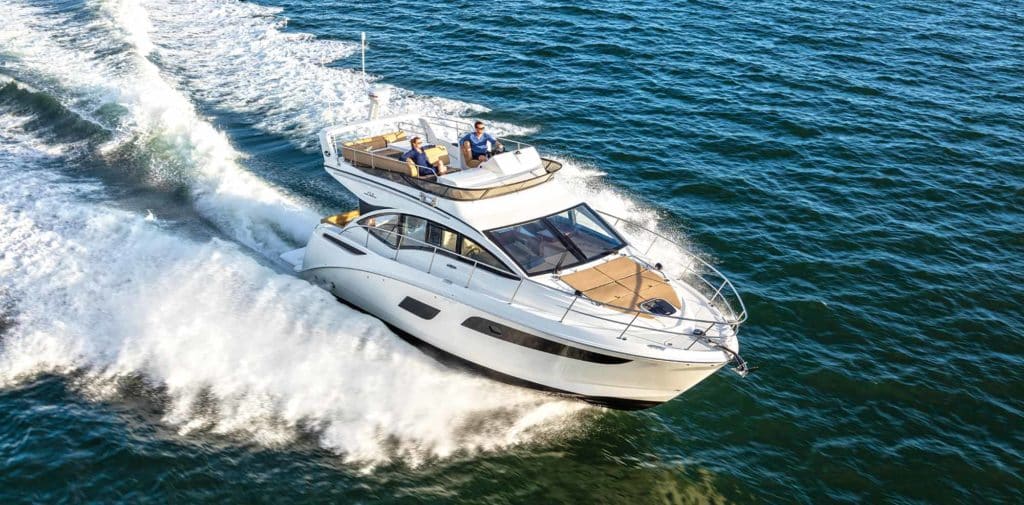
Pain and Gain: Ride Vs. Handling
“Two sharp hulls pound less in a seaway too,” says Morelli. Monohulls, especially cruising monohulls like the Sea Ray, tend to experience bow rise when accelerating, while catamarans remain flat throughout their speed range. It’s generally agreed that catamarans provide a softer ride in a seaway because their knifelike hulls slice the waves rather than crush them, and the motion of a catamaran in waves is more like a cantering horse, which some people like and others don’t. At low speeds in a beam sea, some power cats can have a sharp roll as swells pass under each hull separately, but monohulls also roll considerably, which is why gyrostabilizers and stabilizer fins have become popular aboard monohulls. But the roll moment is different for each, and you may or may not prefer one motion to the other.
In hard turns, catamarans remain flat or even lean outboard somewhat, which can intimidate inexperienced skippers more used to the inboard bank of a monohull. Handling is another factor to consider, and catamarans have both good and bad features. With the engines widely spaced in the two hulls, a catamaran is more maneuverable at slow speed and spins easily by using its engines. A monohull, with the two engines close together, requires more power and technique to spin.
The downside of handling a cat, of course, is the much wider beam: Turning a platform that is more than half as wide as it is long can take planning, especially in narrow channels. Some, but not all, catamarans also have some weird quirks, such as “sneezing” between the hulls when running in some conditons, which sends spray over the bow, and also pounding at times at idle speeds due to air pockets.
Draft is something to keep in mind too, especially if you want to explore shallow waters. The Leopard draws 3 feet 1 inch compared to the Sea Ray at 3 feet 7 inches. The Leopard also has skegs to protect its props, rudders and running gear if you decide to nose up to a beach.
That 22-foot beam has another downside: It doesn’t fit in many marina slips, which means the Leopard is likely to moor on end ties (with more wave motion) or on side ties along a seawall, while the Sea Ray will fit into most any marina slip. Catamaran slips are often more expensive too.
Our take: The catamaran wins for its soft ride in a seaway. The V-hull wins for fitting into a greater number of protected, less-expensive marina slips.
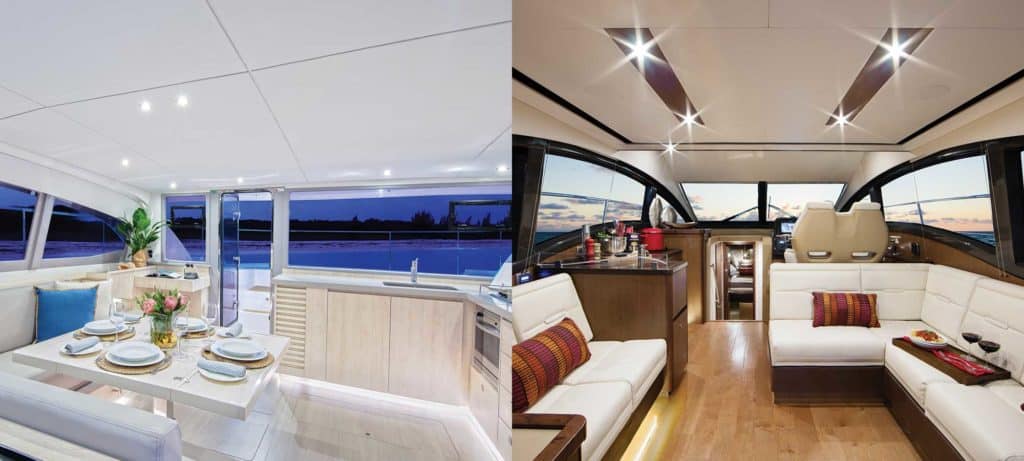
Interior Accommodations – Salon
There’s no getting away from the fact that a 22-foot-wide boat will have more space than one with a 13-foot beam, or so it should seem. But that isn’t quite true. Let’s start with the salon.
Having a 20-something-foot-wide living room is something you don’t find aboard monohulls until you pass the 100-foot length, and this is exactly why catamarans are proving popular with liveaboard owners. In the case of the Leopard, there is a large dinette, a single-seat lower helm station, and a spacious L-shaped galley with counter space measured in acres. Galley gear includes a three-burner gas cooktop with gas oven, and a two-drawer fridge.
The Sea Ray has a doublewide helm station, a pair of facing couches, and a galley aimed more at dining ashore, with limited counter space, a two-burner electric cooktop, microwave and fridge.
While the Leopard salon excels in sheer space (there is room to dance in the salon), it also has one popular feature: a front door. Both boats have sliding doors aft into the cockpit, of course, but the Leopard has an offset door that opens to the foredeck for anchoring or sunning.
Our take: The salon winner is the Leopard catamaran.
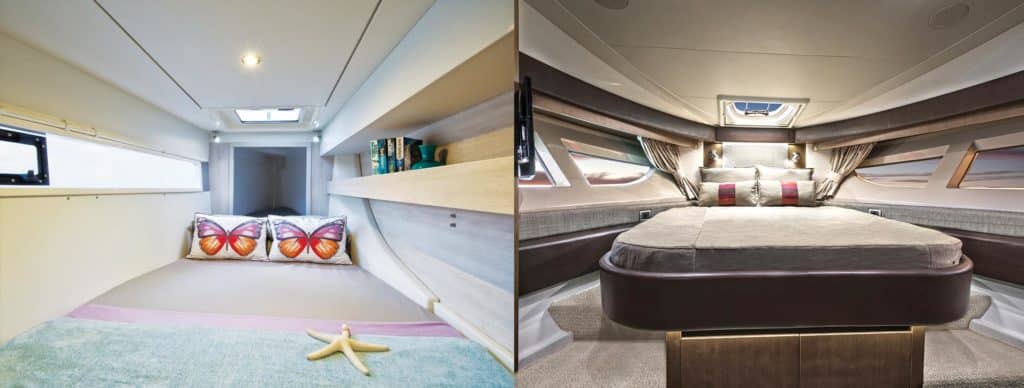
I said “so it should seem” about a wider beam on the Leopard equating to more space, which was true for the salon, but not so much for the staterooms. The Sea Ray has a conventional monohull layout for this length, with the master stateroom forward and a midship cabin under the salon with two berths that can slide together to become a double. The Sea Ray master cabin has a walk-around island queen-size berth, while the midship cabin has limited headroom, but a couch and a separate head are optional.
The Leopard, on the other hand, offers either a four-cabin or a three-cabin owner’s layout. The four-cabin is popular with chartering, placing two cabins in each hull, with a head and stall shower between, while the owner’s version fills the starboard hull with the berth aft and the bow becomes a large head with stall shower.
The shortcomings of the catamaran are the narrow hulls, which limit the width of the cabins. The berths literally fill each cabin, hullside to hullside, making these into less graceful crawl-in berths, and each cabin has limited floor space and stowage.
Our take: We’ll call this even, depending on whether you want more smaller cabins or fewer but more-spacious cabins.

Once again, sheer beam is the determining factor in flybridges. The Leopard has a wraparound dinette, doublewide helm seat, and outdoor galley with barbecue grill and fridge. The Leopard bridge still has ample space for deck chairs or kayaks. A walk-through next to the helm leads to a sun pad on the forward bridge for lounging.
The Sea Ray 400 Fly has a single helm chair and a double companion seat, as well as a dinette and mini galley, but no extra space.
Our take: The Catamaran’s extra width offers a more spacious flying bridge.
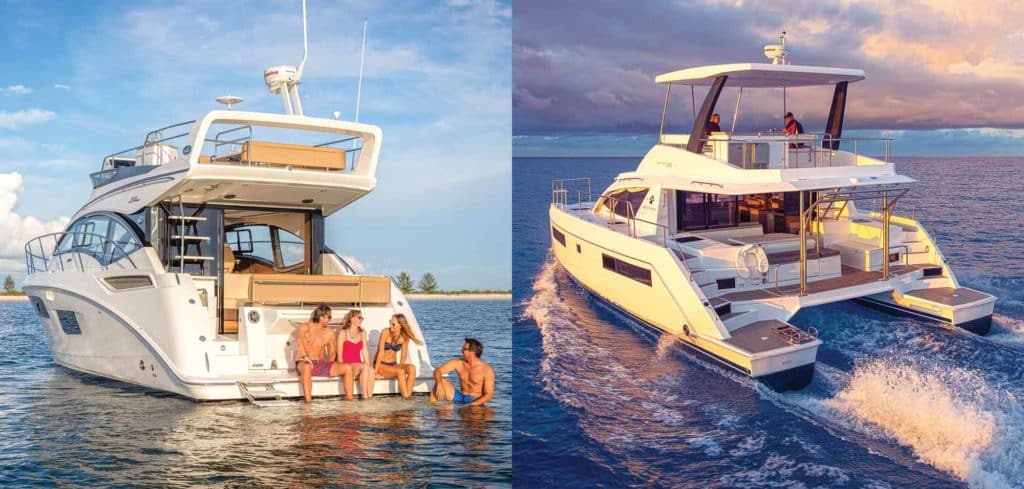
Transom Platform
The Leopard Power Cat has smaller transom platforms, but there are two of them. Leopard created a clever electric davit that can launch or retrieve a tender and provide secure stowage while underway, making tender operations easy. The Sea Ray offers a standard transom platform or an optional hydraulic platform, either of which serves as a terrific “beach” for your crew while at anchor. It can carry up to a 500-pound tender such as a Sea-Doo Spark PWC.
Our take: The monohull’s single wide swim platform is superior for tender handling, swimming and socializing
Fit and Finish
This last item is empirical, and the fact is the two boats are finished to different standards. The Leopard ($459,000 MSRP), like many catamarans, is designed for minimal maintenance for tough charter service, with expanses of fiberglass and Formica-like materials. The Sea Ray ($809,542 MSRP), on the other hand, uses fabrics and finishes that create a more opulent, yachtlike interior.
Engine access on the Sea Ray 400 Fly is good via a gas-lifted cockpit deck, while the Leopard engines are under the berths in the two aft cabins, which rise on gas lifts, but there is some upheaval of two cabins to check the oil. Again, a personal choice: one engine room or two.
Our take: Finish is not strictly a cat or mono attribute. Any boat can be finished to any level, depending upon the builder’s target market.
Catamaran or monohull? Both are right for certain owners and, just like apples and oranges, both taste good for different reasons. Boating ‘s position for decades has been and continues to be: There is no perfect boat, but there is probably a boat that is perfect for you.
- More: Boats , Cruising Boats , Leopard Catamarans , sea ray , versus
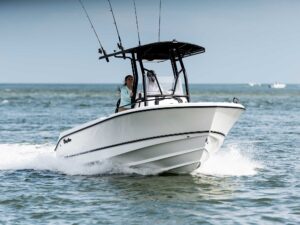
Boat Test: 2024 EdgeWater 208CC Watchman
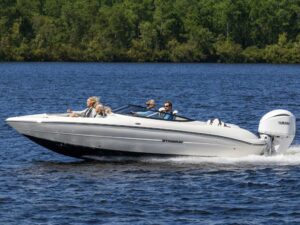
Boat Test: 2024 Stingray 23 OSX
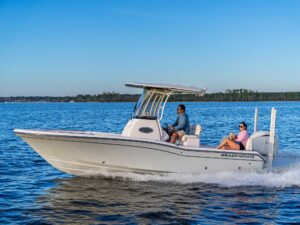
Boat Test: 2024 Grady-White 231 Coastal Explorer
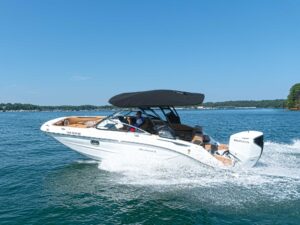
Boat Test: 2024 Hurricane SunDeck 2600 OB
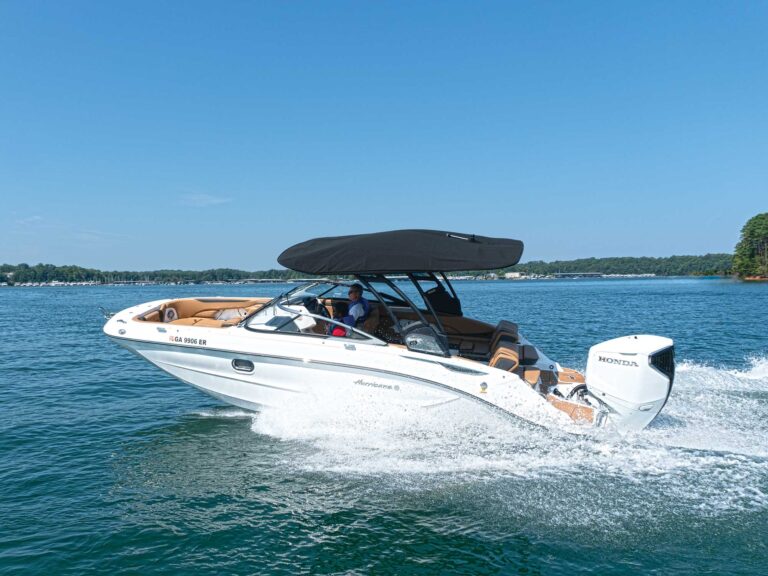
Boat Test: 2024 Brabus Shadow 1200 Sun-Top
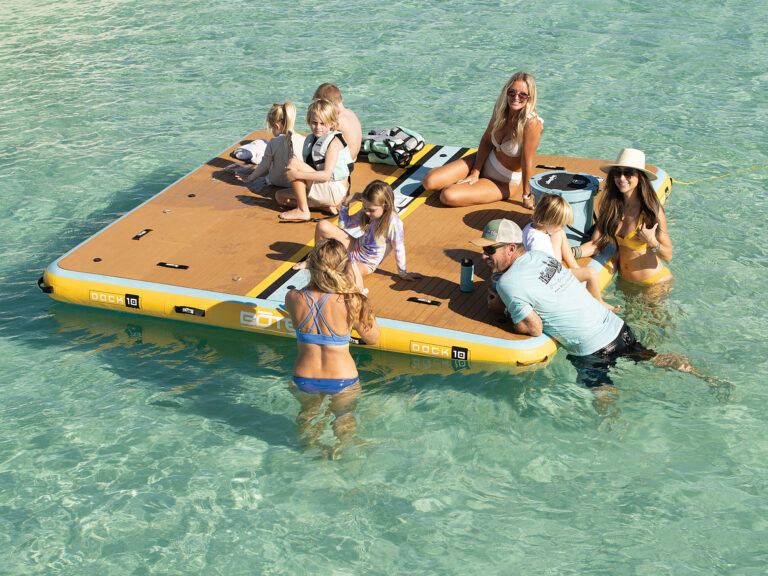
Inflatable Water Mats for Boaters
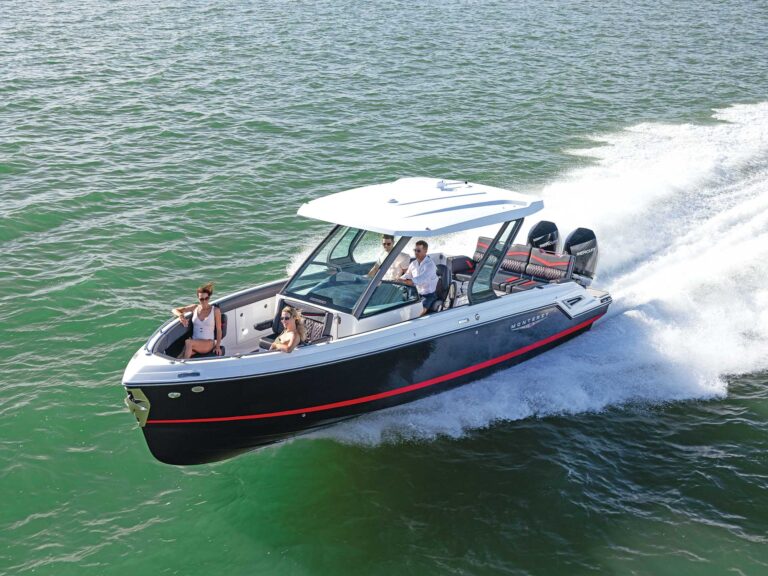
Boat Test: 2024 Monterey Elite 30

- Digital Edition
- Customer Service
- Privacy Policy
- Terms of Use
- Cruising World
- Sailing World
- Salt Water Sportsman
- Sport Fishing
- Wakeboarding
Many products featured on this site were editorially chosen. Boating may receive financial compensation for products purchased through this site.
Copyright © 2024 Boating Firecrown . All rights reserved. Reproduction in whole or in part without permission is prohibited.
ACTIVE STORM TRACKER Hurricane and Tropical Storm Information Learn more

Service Locator
- Angler Endorsement
- Boat Towing Coverage
- Mechanical Breakdown
- Insurance Requirements in Mexico
- Agreed Hull Value
- Actual Cash Value
- Liability Only
- Insurance Payment Options
- Claims Information
- Towing Service Agreement
- Membership Plans
- Boat Show Tickets
- BoatUS Boats For Sale
- Membership Payment Options
- Consumer Affairs
- Boat Documentation Requirements
- Installation Instructions
- Shipping & Handling Information
- Contact Boat Lettering
- End User Agreement
- Frequently Asked Questions
- Vessel Documentation
- BoatUS Foundation
- Government Affairs
- Powercruisers
- Buying & Selling Advice
- Maintenance
- Tow Vehicles
- Make & Create
- Makeovers & Refitting
- Accessories
- Electronics
- Skills, Tips, Tools
- Spring Preparation
- Winterization
- Boaters’ Rights
- Environment & Clean Water
- Boat Safety
- Navigational Hazards
- Personal Safety
- Batteries & Onboard Power
- Motors, Engines, Propulsion
- Books & Movies
- Cockpit Confessions
- Communication & Etiquette
- Contests & Sweepstakes
- Colleges & Tech Schools
- Food, Drink, Entertainment
- New To Boating
- Travel & Destinations
- Watersports
- Anchors & Anchoring
- Boat Handling
- ← Seamanship
The Planing Power Catamaran: A Different Kind Of Cat
Advertisement
Planing powercats deliver the high speeds dayboaters and weekend anglers crave — but without so much pounding in choppy seas.
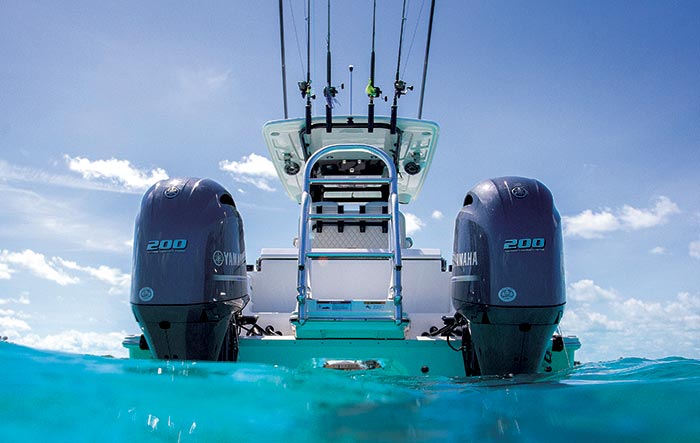
The air cushion created between the two hulls dramatically reduces wave impact at running speeds. (Photo: World Cat)
Powercats are different beasts than sailing cats, and the powercats you're most likely to see on your local waters are those in the 20- to 40-foot range (like my 22-foot Glacier Bay). Unlike the big cruising powercats, which are more like cat trawlers with top ends maybe a little over 20 mph, smaller cats have planing hulls that perform much like today's modern powerboats.
Depending on the engine package, there are a few cats that top out in the lower 30s, lots in the lower 40s, some in the 50s, and a few that break 70 or even 80 mph.
While a similar length monohull may have a 40-mph cruising speed in a 2-foot chop, the monohull captain will pull back the throttles and cruise at 30 to avoid being beaten up. The cat guy, on the other hand, may be able to keep on doing 40 thanks to the smoother ride. But having two hulls underfoot does create some interesting similarities in how these different types of boats react to input from the helm. So you'll see a few of the tips here mirror those used for sailing or cruising catamarans. Whatever type of cat you may be captaining, remember the following:
- Center the wheel and use only the throttles to control the boat. Powercats have their engines exceptionally widely spaced apart, and are far more responsive than monohulls when steered via throttles. Generally speaking, turning the steering wheel will only serve to reduce the effectiveness of working the throttles. This, of course, is assuming you have two engines. There are a few rare cats with one engine.
- At identical rpm, the engine in forward will create more thrust than the engine in reverse. So even if the throttles are set evenly when opposed, the boat will likely slide forward a bit as opposed to spinning in its own length. As a result, when attempting to speed up the maneuver it's usually best to favor giving the reversed engine extra oomph as opposed to the one in forward (assuming you don't want to move forward while turning the boat).
- Check the speed and direction of the wind before docking , and remember that some cats, particularly those with low draft, can be blown around more easily than many monohulls as there may be less hull below the waterline.
- When docking in a new slip for the first time with lines that haven't been preset, bear in mind that once you're docked, securing the boat can be difficult in some situations because few powercats have centered cleats. Most will have a single cleat on either side, in some cases obstructed by a bow rail and/or pulpit, which can make crossing lines difficult.
- Never shut those engines down until all the lines are secured . Again, remember that many cats can get blown out of kilter faster than the average monohull, and if you don't have lines preset, it may take a moment to figure out how to best secure them. Many a captain has done a perfect docking job and then shut off the engines, only for a gust of wind to push the boat right back out of the slip before the lines can be tied. Keep those engines running until the boat is 100% secure so you can apply power, if necessary, to maintain position.
Why Two Hulls?
Like all boats, catamarans come with distinct advantages (smooth ride, draft), and areas of compromise (docking, turning). Regardless of design aesthetics, the first question is usually: Why two hulls?
Mike Myers, vice president of product development for World Cat explains: "Catamaran hulls experience little to no drag or resistance to get on plane, resulting in greater fuel economy. They have a steady rise in speed and fuel burn with little to no spikes in fuel consumption."Planing powercats have a unique trait — which many cat lovers consider the top advantage over monohulls — the impact-absorbing cushion of air created by a compression tunnel between hulls.
And when it comes to beam, catamarans' parallel hulls create reliable stability, which helps to avoid heeling and capsizing, and greatly reduces the vessel roll at rest and at trolling speeds.
"Many boats are primarily designed around comfort for the captain. This usually means anyone at the front or sides of the boat takes most of the jostling,"Myers says. "The catamaran-style hull delivers ride comfort, smoothness, load distribution, and stability."That stability draws anglers to powercats of typically 20 to 40 feet; and cruisers to sailing cats 40 to 60 feet and beyond.
— Rich Armstrong
Taming The Cat
When it comes to handling powercats in open waters, the most important thing to remember is that all boats are different. Just as you wouldn't lump the handling characteristics of all monohulls together, the same goes for powercats. But many have a few common traits to consider.
- Some powercats have relatively low buoyancy in the bow compared to monohulls, as many have very narrow hull entries . As a result, in some cases, idling into a sea can allow waves to break over the bow. Gaining some headway so the bow rises a bit and packs air into the tunnel can alleviate the issue.
- Some planing powercats will run smoother at faster speeds than slower speeds, as they compress air in the tunnel between the two hulls. In these cases, speeding up may actually provide a more comfortable ride in some sea states as compared to slowing down. Depending on your boat, its tunnel may result in other differences from the monohull that you may be familiar with. Learning about these will improve you experience.
- Some powercats display a "snap roll,"which is a very fast righting motion that can rock the boat uncomfortably, especially when drifting in a beam sea. In these cases, people who may want to drift often (such as anglers) will sometimes deploy a drift sock off the bow to reduce rocking and rolling.
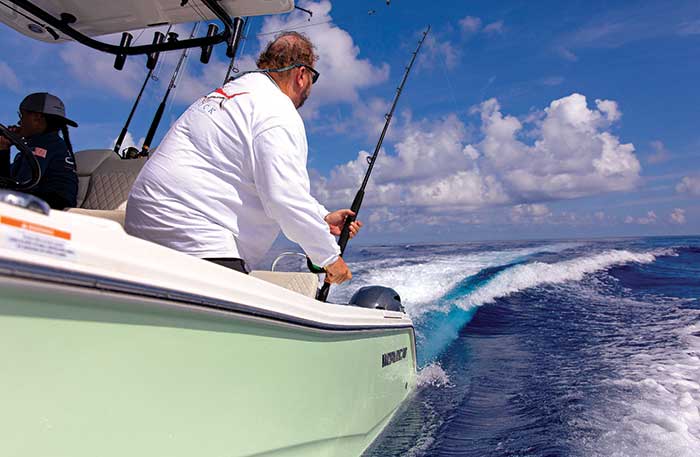
Photo: World Cat
- In general, powercats are often more weight-sensitive than monohulls, especially when the bow is loaded down . It's always best to be aware of how you're loading your boat, and if the tunnel is slapping or the bow is digging into waves, consider shifting weight aft.
- Some powercats, particularly older models, lean out in a turn rather than banking in. There's no way to eliminate this phenomenon (although trimming up an outboard engine when initiating a turn may reduce it a bit), so it's important to give passengers a warning to hold on before making any aggressive maneuvers.
- "Sneezing,"or blowing a puff of mist out the front of the tunnel that the boat then runs through (getting everyone aboard damp), is a phenomenon associated with some powercats. In many cases, trimming the bow up a bit will significantly reduce or even eliminate sneezing.
Related Articles
The truth about ceramic coatings for boats.
Our editor investigates the marketing claims of consumer-grade ceramic coatings.
Fine-Tune Your Side Scan Fishfinder
Take your side-scanning fishfinder off auto mode, and you’ll be spotting your prey from afar in no time
DIY Boat Foam Decking
Closed-cell foam flooring helps make boating more comfortable. Here’s how to install it on your vessel
Click to explore related articles
Lenny Rudow
New Boats, Fishing & Electronics Editor, BoatUS Magazine
Top tech writer and accomplished sports fisherman, BoatUS Magazine Contributing Editor Lenny Rudow has written seven practical boating books, won 30 awards from Boating Writers International — many for his marine electronics articles – and two for excellence from the Outdoor Writers Association of America. He judges the NMMA Innovation Awards, and is Angler in Chief at FishTalk, his own Chesapeake-based publication. A great teacher and inspirational writer, Lenny hosts many of BoatUS Magazine’s very-popular how-to videos, which can be found on the BoatUS YouTube channel, or at BoatUS.com
BoatUS Magazine Is A Benefit Of BoatUS Membership
Membership Benefits Include:
Subscription to the print version of BoatUS Magazine
4% back on purchases from West Marine stores or online at WestMarine.com
Discounts on fuel, transient slips, repairs and more at over 1,200 businesses
Deals on cruises, charters, car rentals, hotel stays and more…
All for only $25/year!
We use cookies to enhance your visit to our website and to improve your experience. By continuing to use our website, you’re agreeing to our cookie policy.

- CREATE AN ACCOUNT
- Boat Cover Finder
- Bimini Top Finder
- Boat Propeller Finder
- Engine Parts Finder
- Anchor & Dock
- Watersports
- Clothing and Footwear
- Engine Parts
- Cabin and Galley
- Covers and Biminis
- Electronics
- Paint and Maintenance
- Pumps and Plumbing
- Anchor Chains & Ropes
- Boat Fenders
- Boat Mooring
- Boat Protection
- Dock Storage & Protection
- Ladders, Steps, & Platforms
- Top Sellers

- Fishing Rods
- Fishing Reels
- Fishing Rod & Reel Combos
- Fishing Tools & Tackle Boxes
- Fishing Line
- Fly Fishing
- Fishing Bait & Fishing Lures
- Fishing Rod Holders & Storage Racks
- Fish Finders, Sounders & Sonar
- Trolling Motors
- Fishing Nets
- Fishing Downriggers & Acessories
- Fishing Outriggers & Acessories
- Fishing Kayaks
- Fish Cleaning Tables

- Inflatable Rafts
- Paddle Boarding
- Paddles & Oars
- Wakeboard, Wakesurf & Ski
- Wakeboard Towers
- Tow Ropes & Handles
- Life Jackets & PFDs
- Snow Sports
- Roof Racks, Carriers, Dollies

Men's Clothing
- Accessories
Men's Footwear
- Atheltic Shoes
- Water Shoes
Women's Clothing
- Dresses & Skirts
Women's Footwear
- Fuel Systems
- Sacrificial Anodes & Zincs
- Generator Parts
- Inflatable Boats
- Propeller Parts & Accessories
- Boat Manuals
- PWC Parts & Accessories

- Fishing Boat Seats
- Offshore Boat Seats
- Ski Boat Seats
- Pontoon Boat Seats & Furniture
- Boat Seat Pedestals & Hardware
- Boat Seats by Manufacturer
- Boat Tables & Hardware
- Boat Seat Covers
- Boat Seat Vinyl
- Floating Boat Cushions

- Barbeque Grills
- Boat Drink Holders
- Cabin Accessories & Hardware
- Boat Ventilation
- Interior & Cabin Lighting
- Marine Teak Products
- Carbon Monoxide & Smoke Detectors
- Binoculars & Telescopes

Boat Bimini Tops
- Bimini Top Accessories
- Pontoon Bimini Tops
- Other Biminis
- RV & Trailer Covers
- Boat Shrink Wrap & Accessories
- Boat Shelters
Boat Covers
- Boat Cover Accessories
- Boat Lift Canopy Covers
- Other Covers
- Boat Wiring & Cable
- Marine Batteries & Accessories
- Marine DC Power Plugs & Sockets
- Marine Electrical Meters
- Boat Lights
- Marine Electrical Panels & Circuit Breakers
- Power Packs & Jump Starters
- Marine Solar Power Accessories
- Marine Electrical Terminals
- Marine Fuse Blocks & Terminal Blocks
- Marine Switches
- Shore Power & AC Distribution

- Marine Audio & Video
- GPS Chartplotters & Accessories
- Electronic Navigation Charts & Software
- Digital Instruments
- Display Mounts
- VHF Radios & Communication
- Marine Radar
- Auto Pilot Systems
- Action Cameras

- Fiberglass & Epoxy Boat Repair
- Boat Paint & Varnish
- Marine Adhesives, Sealant, & Caulking
- Marine Engine Maintenance
- Boat Cleaners & Waxes
- Boat Cleaning Supplies

- Fresh Water Boat Systems
- Bilge Pumps
- Marine Plumbing Parts
- Wash Down Pumps
- Livewell Aerator Pumps & Live Bait Wells
- Toilet & Waste Pumps
- Marine Pump Replacement Parts

- Tires, Rims, & Hub Kits
- Boat Trailer Winches
- Boat Motor Supports & Transom Savers
- Boat Trailer Guides & Rollers
- Boat Trailer Fenders
- Boat Trailer Lights
- Boat Trailer Hardware
- Boat Trailer Jacks
- Boat Trailer Brakes & Axles
- Boat Trailer Tie Downs
- Couplers, Mounts, Hitches, & Locks

- Boat Deck Harware
- Marine Nuts, Bolts, & Screws
- Boat Handles, Pulls, & Rings
- Prop Nut Kits & Hardware
- Boat Cabin Hardware
- Marine Fasteners
- Boat Windshield Parts
- Boat Tubing & Rails
- Boat Mirrors
- Marine Tools & Tool Kits
- Boat Lettering

- Women's Clothing Deals
- Men's Clothing Deals
- Fishing Deals
- Anchor & Dock Deals
- Electrical Deals
- Electronics Deals
- Paint & Maintenance Deals
- Pumps & Plumbing Deals
- Boat Seats Deals
- Trailering Deals
- Camping & RV Deals
- Dealer Login

- Forums Login

- Search forums
- The iboats forum moderators are excited to announce that at this time it appears the iboats forums posting pictures function is working once again. Though we cannot promise for how long, we're hoping for indefinitely.
- General Boating/Outdoors Activities
- Boat Topics and Questions (not engine topics)
Catamaran vs. v-hull?
- Thread starter SeaNile
- Start date Dec 9, 2002
- Dec 9, 2002
Hello,<br /> Does anyone know the similarities between a catamaran vs. a v-hull? I am in the process of buying a new boat, but I have never rode in a cat before. If anyone has some insight on this, it would be greatly appreciated.
Jack Shellac
Lieutenant commander.
- Dec 10, 2002
Re: Catamaran vs. v-hull? I have always owned deep-V's for use in salt water because that was the best design, UP TO the emergence of the catamaran. The cats ride much smoother in rough water and you can run faster than any other design that I know of in choppy water. They're also more stable at low speeds and at rest. I suggest you check them out thoroughly before you make a final decision.
Re: Catamaran vs. v-hull? This will depend a great deal on what the boat is being used for and what size it is. We need to know more about how you expect to use your boat.<br /><br />Kelly Cook
Fleet Admiral
Re: Catamaran vs. v-hull? I don't much care for the looks of a cat but that may be off shoot big time by the ride. The only downside that I see is that handling with one motor out may be difficult as they are so far apart. Also the ones I have seen require a specialized trailer due to the hull design.
Chief Petty Officer
Re: Catamaran vs. v-hull? The cats are reportedly more stable on waves due to the balancing act of the 'two' hulls. A deep vee may list as it rides up the front or back of a wave (unless taking the wave head-on) because the single hull will remain perpendicular to the wave's diagonal surface and roll with the wave. A cat will remain more level because it will have one vee taking the wave at a time while the other stabilizes. The cat will 'cut waves' in this manner. If the waves are very large in proportion to the boat, of course, this effect will diminish as both vees are riding up the same wave.<br /><br />I'm on inland lakes exclusively so I only see waves as large as 2'-3' whitecaps or so, but while the rest of us are getting our butts slammed around in vees the few cat owners are going all out like they're on glass! Cats seem to be at a huge advantage when going fast (very fast)in rough water.<br /><br />Again, my experience is limited to inland waters/small boats so...
Re: Catamaran vs. v-hull? if you can afford it i would get a cat, the only down side i would see is turning in an unexpected high sea swell. but then any boat is a problem. one motor shouldnt be bad either, look at pontoons they are just lighter but same priciple. you will also be suprized at how stable they are when people are moving around. im 170 and my fishing bud is 350 when he moves on my trophy i hang on. thats when i wish i had a cat.
- Jan 24, 2006
Re: Catamaran vs. v-hull? I've been considering a Cat hull. Seems as if their owners really love them because it's hard to find 'em used. They have everything I want: more room on deck and below (in a WAC)for family/lake and a better ride than deep V for choppy water sea fishing. But, I can't quite get over the look of them and the seem so pricey. I'm surprised there are not more topics on Iboats debating the cat hulls versus V. Seems to me like a these boats would be more popular. I'd like to hear some of your opinions about these hull designs and the pros /cons.
Supreme Mariner
Senior chief petty officer.
Re: Catamaran vs. v-hull? Hi all, I have had "V" (mono) hulls for ages before I had my first "cat" (in about 1980 I got my first) now I would not even consider anything else if you are after a fishing boat,not too good for a ski boat though, the advantages of twin hulls far out weigh the disadvantages (and there are a few)good things are stability, ride, space (the boat is basically square) twin motor safety,very easy to control in marina as the motors are a long way apart, easy to put on and off trailer, even a newbee can drive on and off if necessary, a few downsides, initial cost, usually big to tow and store, not real good on tight turns like you would if skiing, (they lean outwards like a car)and maybe a couple of other small things but all in all the best by far for a fishing boat
Re: Catamaran vs. v-hull? if anyone is remotely interested just send me an email with any questions I may be able to answer as I have spent thousands of hours on cats of all sizes doing all sorts of things from abalone diving ,game fishing and shark fishing, don't claim to be a marine expert but have spent a lot of time on the water in twin hulls.<br /> [email protected]
Re: Catamaran vs. v-hull? If the twin engines placed so far apart offers good manuverability, how come the the boat would not turn as well as V at speed? I'm asking because I intend to use it in the lake for skiing with the family.
Re: Catamaran vs. v-hull? because they tend to lead outwards when turning at speed, you can turn but nowhere near as tight as a V which leans inwards, if you want to turn around in a harbour or something, one motor in forward and one in reverse and you can do a turn in your own length (like a v but much much easier)
Re: Catamaran vs. v-hull? a high speed turn can of course be good fun (and exciting sometimes)
Re: Catamaran vs. v-hull? They turn well at speed, they just turn flat . . .<br /><br />If you have a boat now you know that a V-hull banks into turns naturally. This helps to keep all of your passengers seated when you turn. You would not believe the difference in a high speed cat. They literally stay flat. It is quite noticeable if you ever get a chance to watch one.<br /><br />So imagine your observer yells "down" and you take a quick look for traffic and then turn to protect your skier. Well imagine this with one of your passengers leaning over into the cooler. With a v-hull the beer, the ice and the passenger all benefit from the banking. In the case of the cat hull, everything wants to fall over or spill out as the hull stays flat and the direction changes. I personally think it could be pretty dangerous, easily minimized, but I think the opportunity for injury ultimately goes up . . .
Re: Catamaran vs. v-hull? The downside of cats? Running downwind in large following seas in breaking inlets. They are more prone to broaching than monohulls. When waves are too steep for the boat to drive perpendicular to the wave you have to drive at an angle to it. The angle means one hull is at the bottom of the trough and the other hull is on the face of the wave. The upper hull is lifted and puts more weight and force on the downward hull. The downward hull is "stuffed", burries the bow and trips the boat...broach or rollover type things happen. Monohulls aren't as sensitive in this regard and can be driven out of the same situation easier. Some "multihullers" are in denial about this, only because they haven't learned yet. You can see this in action at any bad inlet. There is one nearby where I live and watching boats on big swell days is really entertaining...everbody enjoys watching cats get in trouble. My cousin bought a cat and sold it after his first run though a nasty inlet. He said it was too hard to control compared to monohulls. <br /><br />Then there is sneezing and waves slapping the bridge. If running into big headseas it's best if the bridgedeck stays above the waves. Otherwise it's solid water hitting a big blunt wall. That's why cats are typically so tall. The little things cat owners don't seem to talk about is what you need to ask questions on. In smooth waters none of the above matters.
Petty Officer 1st Class
Re: Catamaran vs. v-hull? cat's are long fast boat if you see of shore racing there a class of them, and they handle rough water real well but watch for stuff, if you have open cabin boat I rather have a v for fishing off shore speed isn't what wanted just to get us there with no break downs,and enough power to get though rough water too just though's i would do.
- Jan 25, 2006
Re: Catamaran vs. v-hull? As mentioned, cats turn flat and may be boring; if you are out for thrills rather than a smooth stable ride. That and hard trailering are the only 2 gripes I have heard of.<br /><br />Mark
Seaman Apprentice
- Jul 25, 2009
Re: Catamaran vs. v-hull? One guy has said trailering is easier for noobies, and another said trailering is harder with catamarans. I would imagine trailering would be no different as far as launching the boat, but retrieving it would be harder as you have to perfectly line up each hull with the trailer bunk. Anyone have catamaran trailering experience? I'm considering buying a cat as my next boat and trailering is my only worry (I dry-rack store my monohull right now).
- Jul 26, 2009
Re: Catamaran vs. v-hull? Hate to bump this thread but I'd really like to know if retrieving a catamaran is more difficult than a monohull
Log in or Sign up
You are using an out of date browser. It may not display this or other websites correctly. You should upgrade or use an alternative browser .
Catamaran Vs V hull power boats
Discussion in ' Boat Design ' started by jucasan , Jul 18, 2008 .
jucasan New Member
I just found out this forum (this is my 1st thread) and I'm interested about learning some basic concepts about boat designs. I'm working in a school project and would like to know which one is the difference about a race catamaran power boat and a V hull race boat. Don't expect any mathematical explanation, just the basics concepts. For example: It's true that V hulls are faster in choppy water but slowers in calm water? V boats makes turns better than cats? Are cats more stable? Tx.
chowdan 1980 PAC41 Liveaboard
jucasan said: ↑ I For example: It's true that V hulls are faster in choppy water but slowers in calm water? V boats makes turns better than cats? Are cats more stable? Tx. Click to expand...
Catamaran Hull Type Power Calculations and more
Hull for power catamaran
How much buoyancy is needed for catamaran hulls?
Catamaran Hull Extensions - for outboards
Want to design only a top part of catamaran, looking of plans for hulls 14m, aluminum
Will air injection in a concave sailboat or catamaran hull make it faster
Catamaran hull question
I need some offsets for a catamaran hull 65' x 8' tall.
Re-using old catamaran hulls
Munson Catamaran Hull Trailer-able Houseboat
- No, create an account now.
- Yes, my password is:
- Forgot your password?


- Forum Listing
- Marketplace
- Advanced Search
- Dock Side Discussions
- General Performance Boats Discussions
V hull vs catamaran
- Add to quote
dschifan said: not even a second thought, CAT all the way devil much better smoother ride, not to mention much better looking Click to expand...
What boats have you owned in the past? Cat or a V!
I have owned about 10 vee's in various sizes, fresh and salt. I now own my first cat and there is no compairison. Cat by a long shot.
x2... Randy, the owner of MTI is a true racer... If you can bank roll this kind of toy you can afford a trip to St Louis to meet Randy and take a tour of his place... I have been watching the boats he rolls out of his place for a long while now, I think they are stunning... As for the surf drives, they look indestructable and far easier to wrench on... I have been looking at them close up and can't believe how stout they are built... P.S. How is your back???
Nortech for ammenities, MTI for performance (although not by much), Cigarette who? That being said, I absolutely love the tradition, styling and heritage of the cig, just wouldn't compare to me given the other two... Solely preference.
Take the wifey with you on the test runs just to keep things in check. It would be a bitch to be boating by yourself.
I think a 36' Nor-Tech or MTI would be the perfect boat for you. Both perform well in ocean conditions and are small enough for your lakes. Another option is the 42MTI with the Poker Run cockpit. This boat has a much bigger cockpit and cabin than any other cat except the Ocean Express; http://www.offshoreonly.com/classifieds/2002_44_mti_rare_breed-o21073-en.html This is probably the best example of this setup and Mark takes great care of it. Give him a call he wants to sell it. If I had the wherewithall the boat would be mine right now.
catmando said: I think a 36' Nor-Tech or MTI would be the perfect boat for you. Both perform well in ocean conditions and are small enough for your lakes. Another option is the 42MTI with the Poker Run cockpit. This boat has a much bigger cockpit and cabin than any other cat except the Ocean Express; http://www.offshoreonly.com/classifieds/2002_44_mti_rare_breed-o21073-en.html This is probably the best example of this setup and Mark takes great care of it. Give him a call he wants to sell it. If I had the wherewithall the boat would be mine right now. Click to expand...
...btw do you haul ltl? I need work...
Do I haul what?
Something to keep in mind when purchasing a cat, Do you have cat experience? If not your insurance rates will be a lil higher the first year. Something alot of people dont think about until they have made the purchase. "Just a lil insight". Call me if you have any Insurance questions, I would love to help!!! Btw-Both are beautiful boats!!!!!
If you go with the cat, I hope you and your brother are really good friends. You will have to be because he is going to be sick the first time he gets out of that V and rides in your cat. Many partnerships have been scuttled for less. Good Luck. LT
The idea of someone stepping into a 44' cat with twin 1075's as their first cat kinda scares me.
you need alot of seat time at 100 MPH,before you step into that setup....
You could point out a few guys in desert storm....that may of gone the schooled route......
KAP said: Fountain in the same length and power will be quicker than a Cig anyday of the week. Click to expand...
just for the record the 36 nor tech cat is vey close to 40' dont rule it out.. it their best seller for a reason..
Take a very close look at the Skater 399 "V". This really is the "Cat Killer" hull. With that power you will be in the low to mid 130's. Probably, the best V hull built today. Although, skater is not really known for their creature comforts you could buy the hull and have someone like Schiada or Prime Marine do the interiors and rigging. That would be my choice. You also get four seats across the back!
One other note! You should really look at the Skater cats as well.
I went to there web site and checked them out. Not bad looking boats but don't really care for how the cockpit is laid out.
You know you want the 44 MTI sittin sideways on the trailer....it's baller status...seems like you have made it to that point where you can afford it....so I say GO FOR IT. Cat all the way with all the sick colors and bling and huge reliable power. You have no need for a boat like that in a lake but it is SO BADASS. The cat will be night and day smoother and more comfy than a V, definately faster....on the flip side the V is very fun because it is not as smooth and feels faster at the same speed. You won't have any trouble with the speed if you have a brain, take time to learn, go to school, and know your limitations. if you have been close to a 100 in a 21 flatty then that huge cat at 100 is a walk in the park. That boat would be great to show off in Havasu but Mead has the space for that boat to really stretch out .... Good luck
MTI is faster than a Nortec. But my vote is a Cig.
If you can afford those boats, you can afford a class at Tres Martin's. It will be worth the money. A big cat with big power won't run worth a crap between 40 and 70/80 or maybe 90mph. At those speeds where most boats on the lake run, it will lean like crazy to outside and be dangerous to turn. Honeyman rolled his Skater at 45. A big vee like a Cig or Fountain with a step bottom going 80+ will also be dangerous to turn. It's not a little stepped west coast vee, those big boats are dangerous if you don't know how to trim and steer them when you going fast. A couple of years back an Outerlimits spun at a poker run killing two passengers. So my advice would be get some classes. The 46 cig is sick, but I wouldn't turn down an MTI either. What a dilemma to have.
Why would it lean at slow speeds? I would think that at slow speeds due to how the boat is built it would stay level.
- ?
- 41.8K members
Top Contributors this Month
- THE PRINCESS PASSPORT
- Email Newsletter
- Yacht Walkthroughs
- Destinations
- Electronics
- Boating Safety
- Ultimate Boating Giveaway

Discover the Top Power Catamarans for 2024
- By Yachting Staff
- Updated: September 10, 2024
Power catamarans have seen a surge in popularity, growing both in size and appeal. These cruise-focused yachts offer homelike comfort, fuel efficiency and user-friendly operation, making them a favorite among avid travelers. Their popularity extends to the bareboat charter market for the same reasons.
In this article, we explore the world’s top power catamarans, ranging from a 36-footer ideal for a cruising couple to a 78-footer perfect for entertaining friends and family. The propulsion options are diverse, including outboards, diesel inboards, hybrids, and even all-solar setups.
Top Luxury Power Catamarans
The following power catamarans are all vessels we’ve reviewed. They are listed in no particular order.
- Fountaine Pajot MY44 : A family-oriented cat suitable for long-range cruising and aimed at owner-operators.
- Silent Yachts 60 : This is a catamaran that can cruise comfortably for long distances using emissions-free solar-electric propulsion.
- Horizon PC74 : With interior and deck space like a much larger vessel, the PC74 is perfect for cruising the Bahamas and Caribbean.
- Aquila 36 : This beefy 36-footer is an outboard-powered, express-cruiser-style catamaran.
- Lagoon Seventy 8 Powercat : A spacious design, this vessel fits the volume of a 130-foot-long monohull into just 78 feet of length overall.
- Horizon PC68 : This cat has a stable ride, long range, volume to spare and intriguing layout options.
- Two Oceans 555 : An elegantly simple yet luxurious 55-foot custom with the space and amenities of a much larger vessel.
- Lagoon 630 : From its open salon to its spacious decks, the Lagoon is a comfortable and luxurious platform.
- Fountaine Pajot MY5 : A midsize cruiser with serious big-boat space for family and friends.
- Prestige Yachts M8 : The voluminous 65-footer lets owners customize onboard spaces.
- Aquila 47 Molokai : Calling all anglers: This cat has 60-plus-knot speed and is set up for serious bluewater adventure.
Fountaine Pajot MY44
The Fountaine Pajot MY44 , a creation of Italian architect Pierangelo Andreani and French designer Daniel Andrieu, has a main deck that’s open from the aft-deck seating all the way forward to the starboard helm station. The sense of spaciousness is significant, for several reasons. First, four glass panels aft can all slide to port, creating an indoor-outdoor space with the aft deck and salon. In the salon, 32-inch-high windows extend for 12 feet down the sides of the yacht, with three sections per side, bringing in natural light along with the three forward panes that comprise the windshield. Finally, 6-foot-6-inch headroom provides vertical clearance, with a 21-foot-7-inch beam that adds interior roominess while keeping the yacht stable.
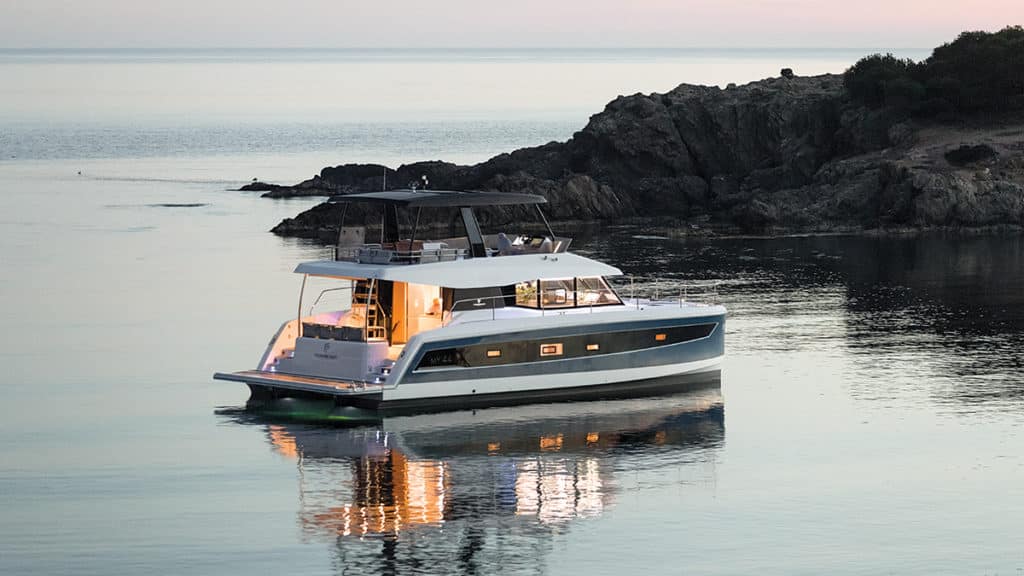
Quick Specifications
| 44’ | |
| 21’5” | |
| 530 gal. | |
| 184 gal. | |
| 6’6” | |
| 32,850 lb. |
Silent Yachts 60
Solar panels, ocean-crossing range and self-sufficiency define the electric Silent-Yachts 60 power catamaran. If there was any question that the “Tesla moment” has arrived in yachting, the Silent 60 clearly provides a positive response. Consider, for a moment, crossing oceans in silence at 5 to 6 knots without consuming a drop of fuel and never needing to plan your course between fuel stops. Imagine sitting at anchor and running the air conditioning all night, not to mention all the galley appliances plus the washer-dryer, without the hum or fumes from a genset.
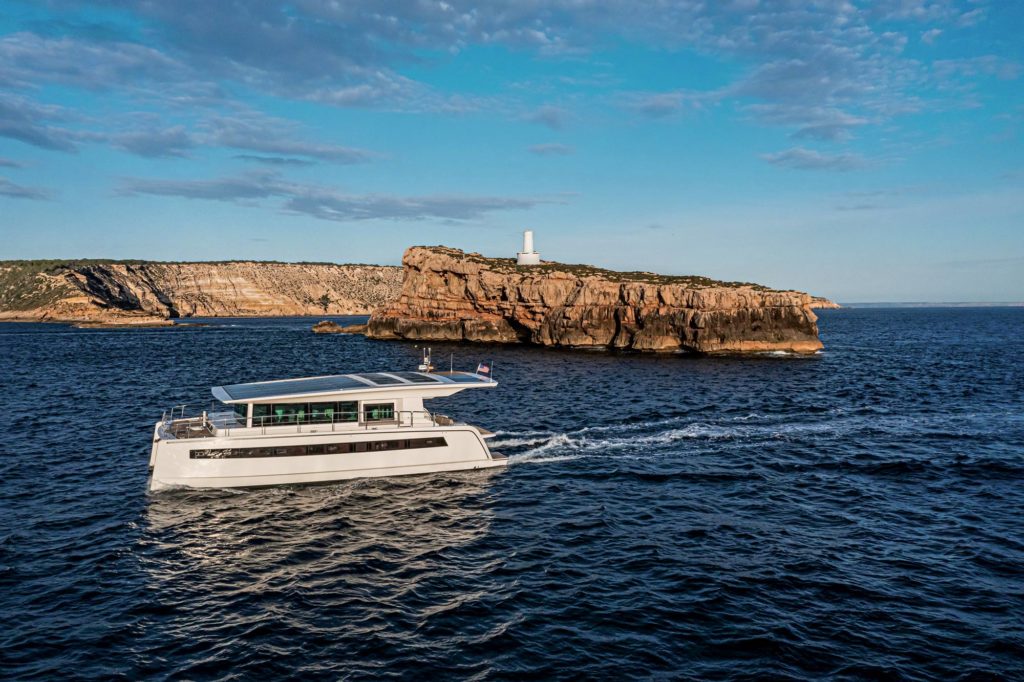
| 62’ | |
| 29’6” | |
| 4’5” | |
| 68,000 lb. |
Horizon PC74
As founder and director of The Powercat Company, a Horizon Power Catamarans distributor, Stuart Hegerstrom had long believed that catamaran builders needed to design their yachts to more stylish standards.
“The boats were very boxy,” he says, based on his years of experience with cats in the charter market. He and his partner, Richard Ford, asked Horizon to produce models that had high-end finishes and looked good inside and out.
The Horizon team brought in mega-yacht designer JC Espinosa to work with its own craftsmen. The result aboard the Horizon PC74 is a catamaran with exterior styling, layout and functionality that should appeal to private and charter owners alike.
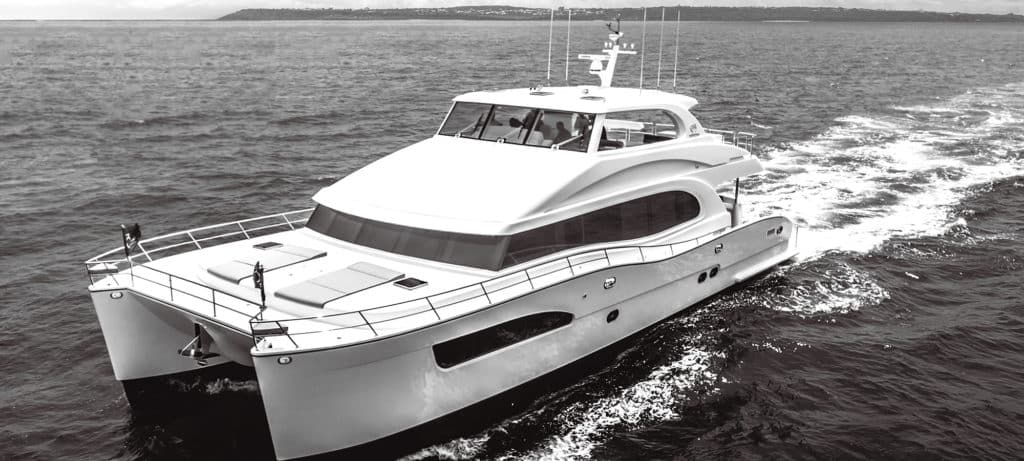
| 73’9” | |
| 28’3” | |
| 2,000 gal. | |
| 400 gal. | |
| 6’ | |
| 163,140 lb. |
The Aquila 36 is a departure from her sisterships in that she is an outboard-powered, express-cruiser-style catamaran, but she also adheres to MarineMax’s philosophies.
With a single main living level from bow to stern and a beam of 14 feet 7 inches, the Aquila 36 is like a bowrider on steroids. She has seating that can handle 20 adults for outings and barbecues, and there are two staterooms below, one in each hull, for family weekending. The staterooms have nearly queen-size berths, en suite heads, stowage and 6-foot-6-inch headroom.
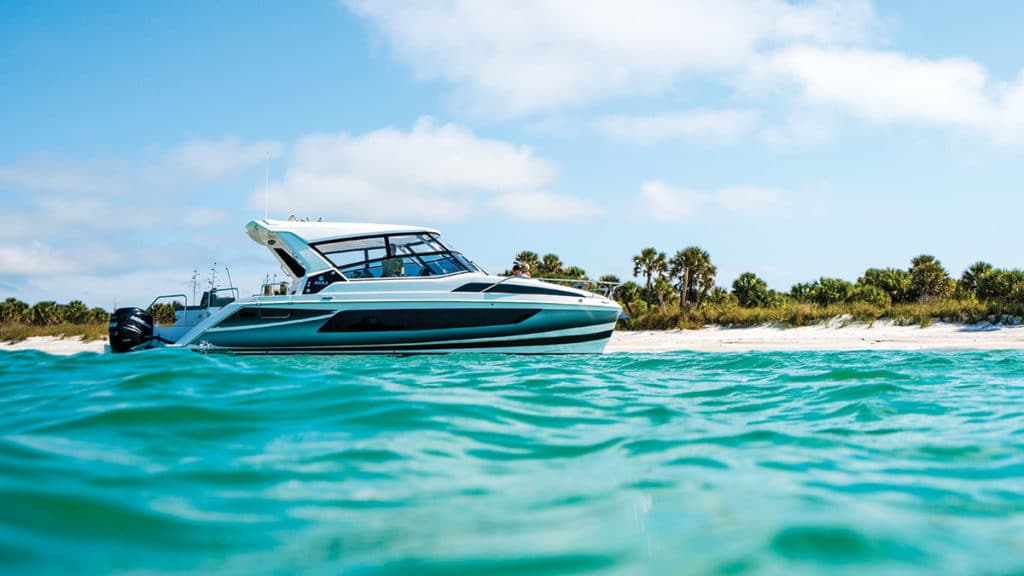
| 36’ | |
| 14’7” | |
| 356 gal. | |
| 200 gal. | |
| 2’ (engines trimmed up) | |
| 21,572 lb. |
Lagoon Seventy 8 Powercat
Lagoon is a division of Groupe Beneteau, the world’s largest builder of sailing yachts, and the Lagoon Seventy 8 Powercat is a developmental sistership of its Seventy 7 super sailing cat. The Seventy series yachts are built at Construction Navale Bordeaux in France, which had to add a new yard to construct these catamarans because they require separate stern molds for the power and sail versions.
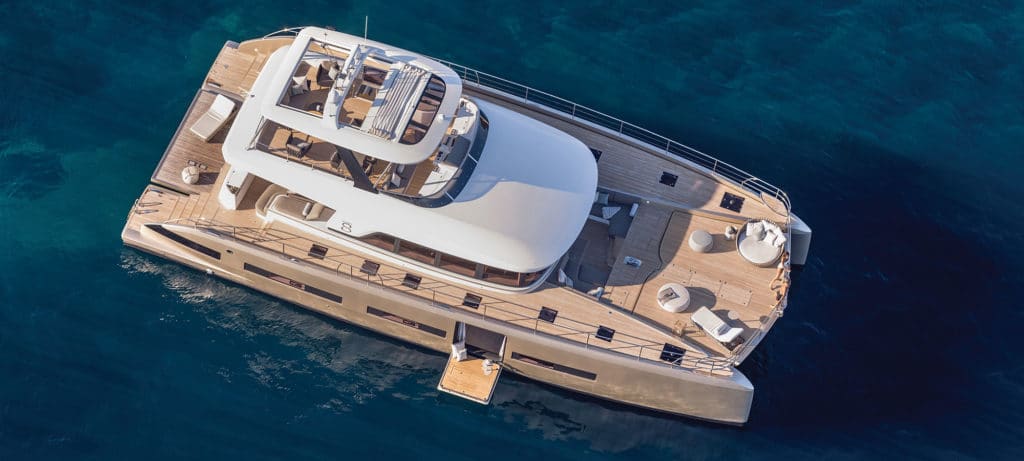
| 78’1” | |
| 36’1” | |
| 2,246 gal. | |
| 422 gal. | |
| 4’2” | |
| 131,153 lb. |
Horizon PC68
Multihull yachts ride differently than monohulls, often counteracting the sea’s motion for a smoother, more stable ride. On the Horizon PC68 , sharp hull entries make head seas seem gentle, and a Humphree stabilization system with blades reduces roll. Horizon uses SCRIMP construction for resin saturation that maximizes strength with an 111,112-pound displacement. And with a 5-foot-4-inch draft, the PC68 invites island cruising.
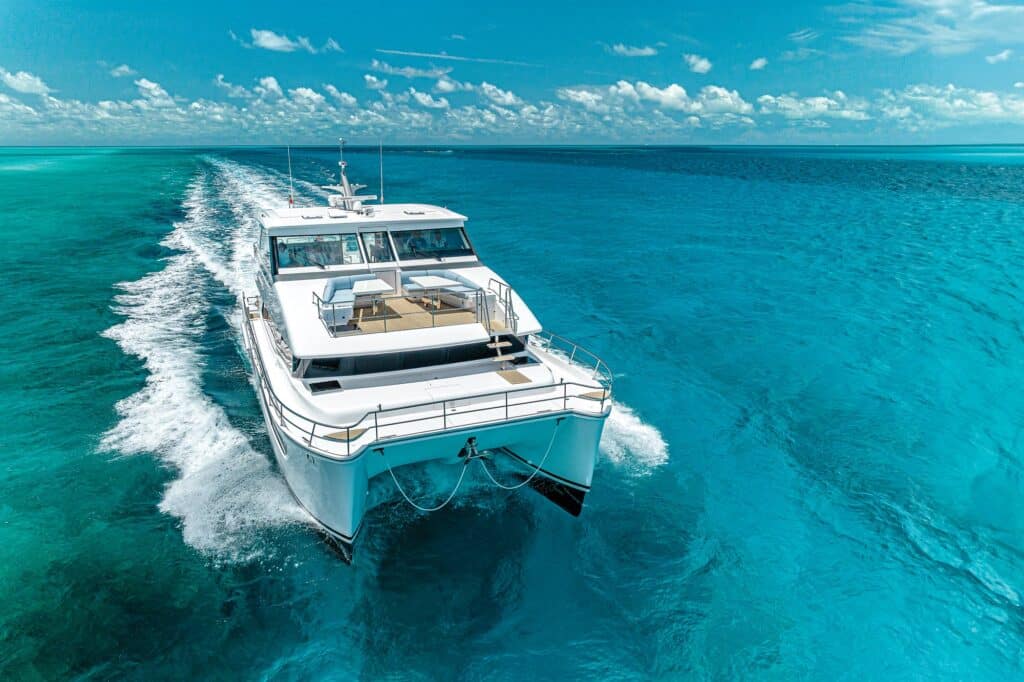
| 60’9” | |
| 24’6” | |
| 1,000 gal. | |
| 250 gal. | |
| 4’9” | |
| 83,467 lb. |

Two Oceans 555
With 27-knot speed, house-like volume, an on-deck master and top-tier tech, the Two Oceans 555 is a formidable power catamaran. Dave Jirikovic of HMY Yachts was on a quest. The sales broker was looking for the meanest, nastiest patch of Gulf Stream he could find to show a potential client what the Two Oceans 555 power cat could handle. And just as he had intended to show us, the broad-shouldered power cat didn’t even notice. He even dropped the single-lever throttles back to idle and left the 25-foot-wide Two Oceans 555 beam-on to another set of square-edged seas. The 55-footer brushed that off too. Jirikovic tried quartering into the seas—never a happy angle for catamarans—and the yacht drowsed through them.
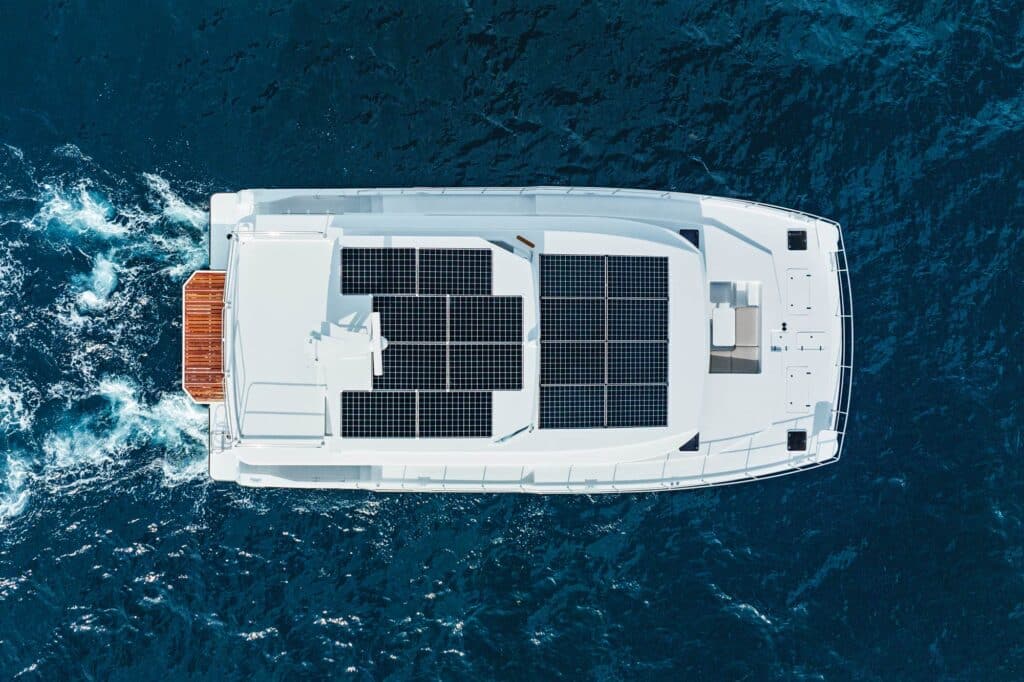
| 55’6” | |
| 25’ | |
| 750 gal. | |
| 200 gal. | |
| 49,600 lb. |
Fitted with the optional twin 300-horsepower Volvo Penta D4 diesels, the Lagoon 630 MY burns only 1.64 gph total at 6 knots, giving a theoretical range of 2,952 nautical miles with standard tankage of 793 gallons. Hull No. 1 had an optional 502-gallon tank, giving it transatlantic range.
Luxury, stability and economy are all hallmarks of Lagoon’s return to luxury motor yachts. If you can take a ride, it will be worth your time.
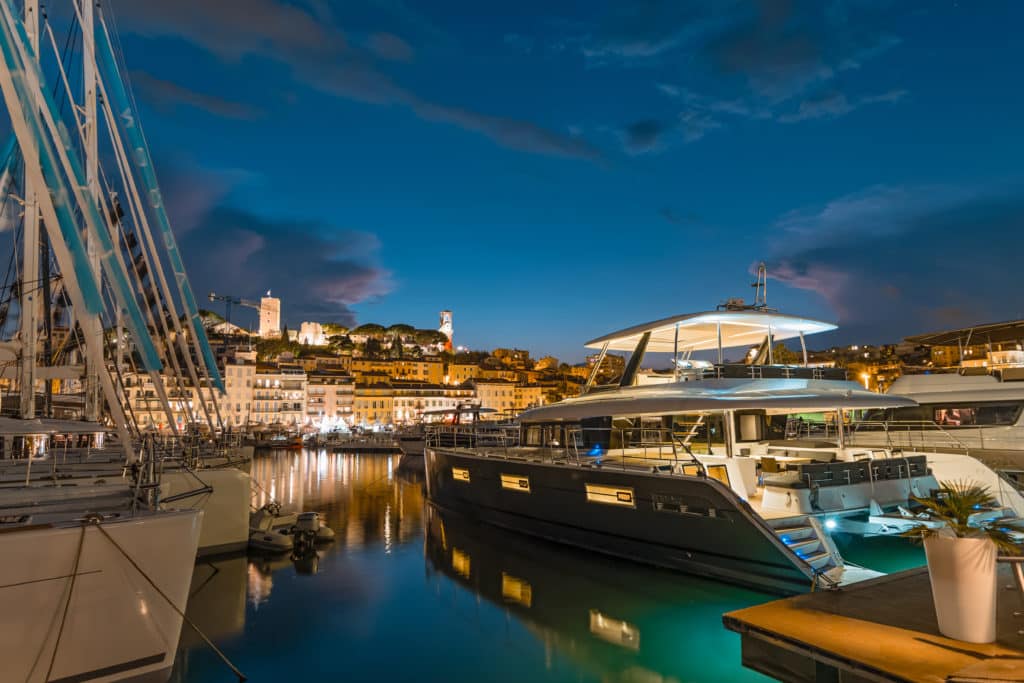
| 64’ | |
| 32’10” | |
| 793 gal. | |
| 254 gal. | |
| 3’11” | |
| 70,097 lb. |
Fountaine Pajot MY5
The flybridge deck on the Fountaine Pajot MY5 is a standout feature, offering virtually unobstructed 360-degree ocean views and an elevated beach club vibe. Aft of the off-center starboard helm is a spacious area perfect for entertaining, complete with a wet bar, refrigeration center, and ample seating. It’s the most popular space aboard according to the builder. And if the weather turns for the worse, a second helm station in the saloon allows the skipper to pilot the MY5 in climate-controlled comfort.
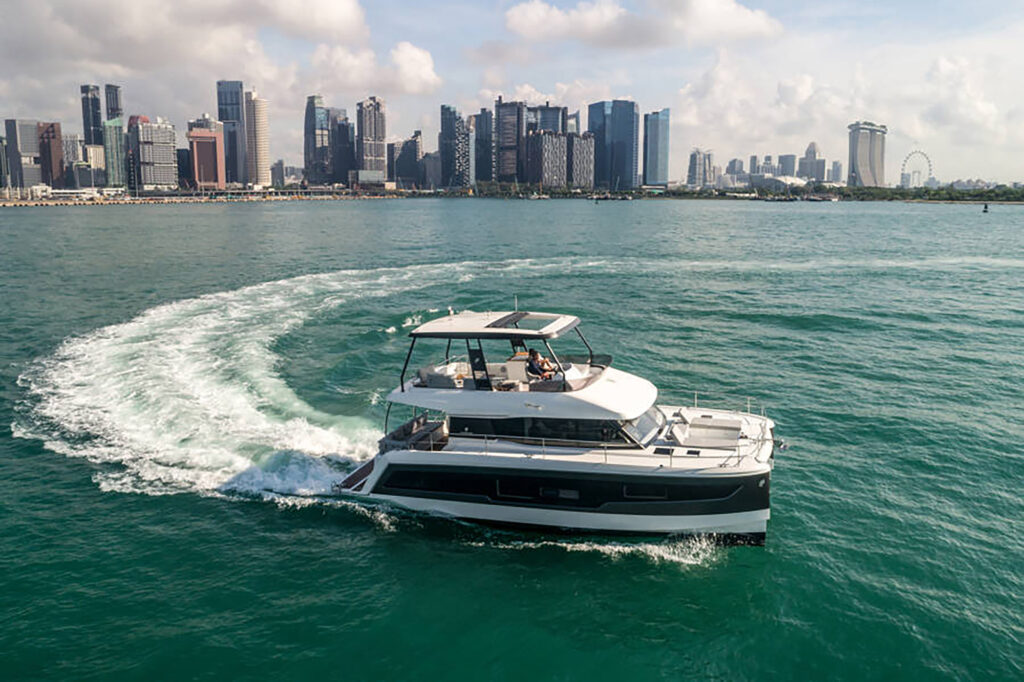
| 42’4” | |
| 19’9” | |
| 372 gal. | |
| 112 gal. | |
| 3’7” | |
| 46,000 lb. |
Prestige Yachts M8
How fitting it was that Prestige Yachts introduced its new M-Line flagship, the M8 , at Portopiccolo, a picturesque yachting village outside Trieste, Italy. Formerly a quarry, the cliff-side area had been chiseled into a clean site rife with eye-catching vistas, much like the French builder’s 65-foot power catamaran and its nearly 3,000 square feet of usable real estate.
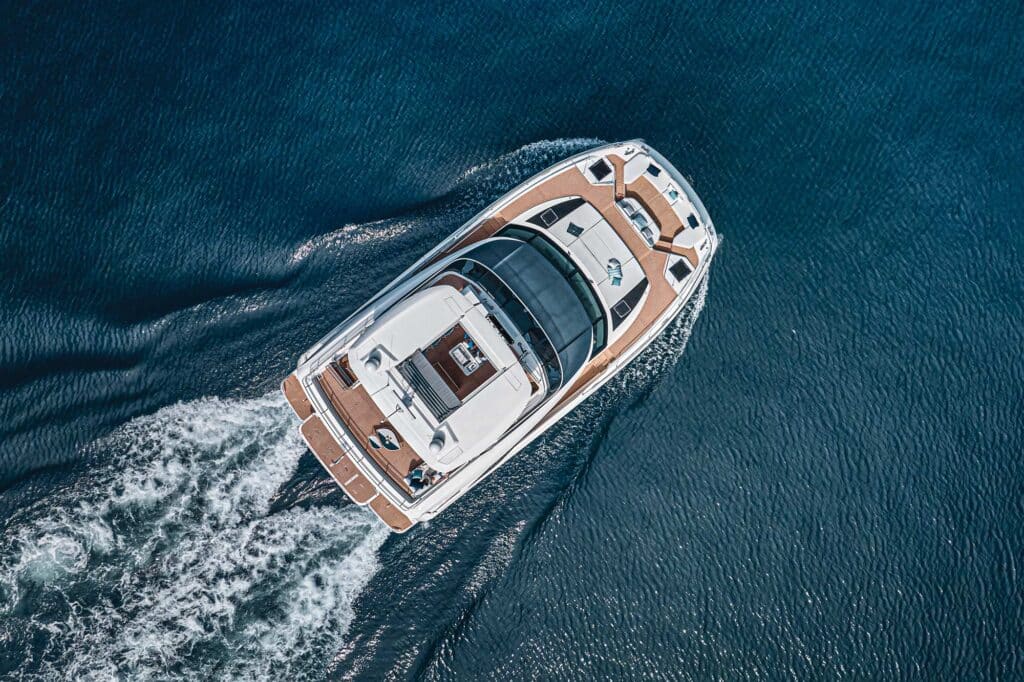
| 65’ | |
| 29’ | |
| 978 gal. | |
| 224 gal. | |
| 5’5” | |
| 98,379 lb. |
Aquila 47 Molokai
With every boat, there’s an origin story. In the case of the Aquila 47 Molokai power catamaran, it starts with MarineMax, which saw people renting boats for bareboat charters. MarineMax Vacations was born. After experimenting with several production yachts, the company decided to build its own: the Aquila line, designed for charter as well as for sale to owner-operators.
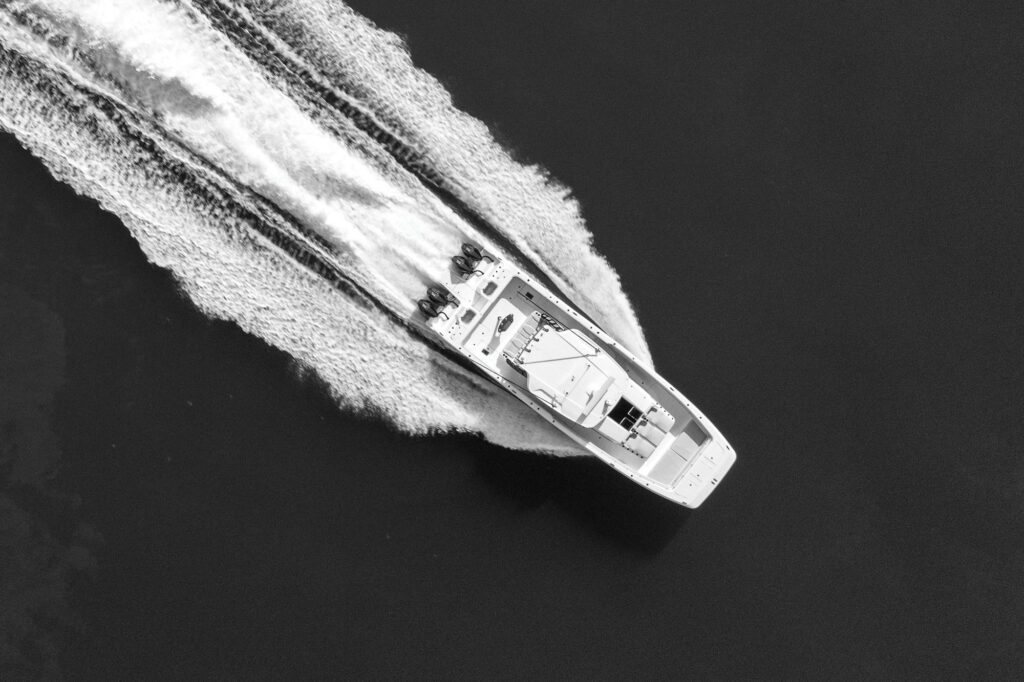
| 49’4” | |
| 14’7” | |
| 1,048 gal. | |
| 2’2” (engines trimmed up) | |
| 22,818 lb. |
- More: Aquila Boats , Fountaine Pajot , Horizon Power Catamarans , Lagoon , Lagoon Catamarans , Power Catamarans , Prestige Yachts , Silent-Yachts , Two Oceans , Yachts
- More Yachts
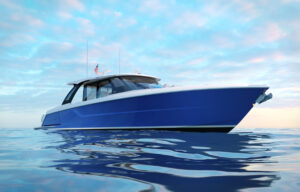
Coming Next Year: Tiara Yachts 56 LS

Top Nine Fishing Tenders For 2024

First Look: Meet the Apreamare 88 Motoryacht Flagship

Holterman Shipyard Debuts Xtreme X-65

Have it Today: 1997 Hatteras 116 For Sale

Cruising into Adventure: Discover Nantucket

Unique Design: 2021 Downeast 54-foot Custom For Sale

- Digital Edition
- Customer Service
- Privacy Policy
- Terms of Use
- Email Newsletters
- Cruising World
- Sailing World
- Salt Water Sportsman
- Sport Fishing
- Wakeboarding
Introduction
The benefits and compromises of owning a power catamaran are usually obvious for different consumers, depending on their circumstances, boating ambitions and level of experience. However, a rapidly growing number of seasoned boaters are learning the joys of owning a catamaran and end up becoming firm catamaran supporters.
We have witnessed amazing changes to how families go boating together on a catamaran. For many families, the catamaran yacht has enabled their kids to join and bring their friends without overcrowding the boat. Guests do not have to be seasoned yachties to enjoy the day in the stable and protected cockpit. While entertaining can be done with style and without stress.

The most compelling argument of all must be this: seasoned monohull boaters are converting to catamarans by the truckload. Many converted former motor yacht owners are now passionate advocates of power catamarans. For experienced yachties demanding performance, the advantages are simply too great to ignore. It is rare to hear of any catamaran owners ever going back to a monohull. Once you become a catamaran owner, you are hooked for life.
“Why should I buy a power catamaran instead of a similar sized motor yacht?”
We are regularly asked by buyers “why should I buy a power catamaran instead of a similar sized motor yacht”. Like everything, there are benefits and compromises to the power catamaran. Despite ourselves being firm Catamaran converts and lifetime believers, below we offer a balanced comparison of the pros and cons.
Advantages of Monohulls
A monohull, as the name implies, has just one hull. This is the most common type of hull design, but why? To produce a well balanced comparison lets start by investigating the benefits of monohulls:
Slow roll period
- Many brands and builders to choose from
More usable space below waterline
Familiar handling.
While monohulls roll back and forth far more than a catamaran, monohull fans will argue that the slow roll period of a monohull has a comforting effect.
There any many brands and builders to choose from as most builders still only produce monohulls. Whilst this trend is changing, 50+ years of composite boat building has been heavily monohull focused. This does mean that there is a far greater selection of vessels, designers and brands and builders to select from.
Whilst the monohull comparably has less interior space, the wide waterline beam (width) allows for greater use of the internal hull height. This either enables builders to mount tanks and storage below cabin floors or to actually expand the cabin below waterline. As a catamaran gains performance via its light displacement and narrow waterline beam, this is often not practical on a catamaran.
Jumping from one boat to another will feel extremely familiar as the differences in handling between brands is minimal, with the exception of planning hull vs displacement hull. Focusing on planning hulls, however you will quickly feel familiar jumping from one boat to another. On the contrary, the difference in handling from a monohull to a power catamaran are immediately apparent.
Disadvantages of Monohulls
Now that we have seen the advantages of a monohull, lets analyse some disadvantages one might encounter while boating on a typical V-bottomed or deep-V motoryacht.
Low stability
Bow steering, rolling at anchor, significant bowrise.
Due to the wide flat hull shape required to get the monohull more quickly into planning mode, it can produce a rather bumpy ride when motoring through waves. Performance through waves can be significantly improved or diminished depending on the hull shape. For instance, a deep V hull will be more comfortable through waves than a shallow V. However, both are significantly outperformed by even the worst power catamaran designs.
A monohulls heel angle is directly affected by weight placement. Moving too much weight to port or to stbd will cause the vessel to heel. This is significantly noticeable when at anchor however even underway an incorrectly loaded monohull can dangerously heel. This can be overcome underway by the use of trim tabs. However, is best overcome by conscious weight placement and management.
Bow steering usually occurs when motoring at speed in a following sea or when passing another vessels wake. If you are inexperienced and do not know what is happening it can be quite frightening. Basically, the boat will suddenly and often expectantly turn hard in one direction while rolling hard in the opposite direction, despite your efforts to steer straight. Bow steering can be prevented with the installation of trim tabs. They can enable you to raise the bow up and out of the water when in a following sea. Trim tabs are not needed on a catamaran due to the natural separation of hulls bow steering.
At times you will undoubtedly come across anchorages that aren’t completely flat. When this happens, monohulls, that rely on the weight of their COG (center of gravity) to be aligned below their COB (center of buoyancy) to keep them upright, will start to rock from side to side. Things roll around inside, plates go flying. It’s uncomfortable or sometimes impossible to cook, and only the hardiest of yachties will be getting any sleep.
While all of this is going on, at the next mooring ball, the power catamaran owners are sitting in their cockpits sipping sun-downers, barely noticing the movement, quietly getting tipsy before a long night’s sleep.
The degree of bowrise varies with monohull designs. However, for those of you unfamiliar with this term, bowrise is the tendency of a boat to point its bows up in the air before it gets into planning mode and then settles somewhat. This puts passengers through an uncomfortable, and sometimes unnerving experience whilst also exposing the vessel to a decreased level of stability and safety.
POWER CATAMARAN
Advantages of power catamarans.
Whilst individual designs can vary by design and their usage, the benefits below are typically universal for most catamarans. In comparison to the equivalent length monohull a catamaran shall deliver the following advantages:
Superior ride comfort
Enhanced stability at anchor and underway, up-scaled cabins and interiors, larger single level cockpit and saloon, significantly improved fuel consumption.
- Drastically improved close-quarter maneuvering
Catamarans experience slower deceleration through wave impact. This significantly reduces slamming through waves. This has been measured with accelerometers in like for like tests to have a 25% reduction in G forces when riding over waves.
Due largely to their wider beam, catamarans have a remarkably higher righting moment compared to monohulls. This prevents them from rolling side-to-side when at anchor, and keeps them sitting level both underway and at rest . This is regardless of placement of people or luggage, this also eliminates the need for catamarans to use trim tabs.

More interior volume, especially in power catamarans that carry their beam all the way forward. Even applicable in the smallest cats that will usually have stand up headroom in each cabin, unlike smaller monohulls. As a result of this increased volume, a power catamaran will always feel over sized – more fairly compared to a monohull 15-20% longer in length. A 35ft power catamaran for instance is more fairly matched against a 43ft motor yacht.
Catamarans generally provide far more living space in the main salon and cockpit in comparison to similarly priced monohulls. The galley, main salon and cockpit are also all on one level, above the water line … making life aboard as well as your view much more enjoyable.

Due to their reduced displacement and wetted surface area power catamarans are impressively efficient. The wider monohull bows create a large bow wake and greater resistance, which require more HP to get onto plane. Not only does this burn more fuel, but also enables a catamaran to get onto plane under just one motor. This is a significant safety advantage, enabling a boat with only one working engine to return to shore before dark rather than limping home at below planning speeds. The ability to plane at lower RPM’s enables cruisers not wanting to travel at groundbreaking speeds to achieve highly efficient low speed planning. Vastly expanding their cruising ground while not breaking the bank nor taking all day to get to the next anchorage. Learn more about power catamaran fuel consumption HERE>>
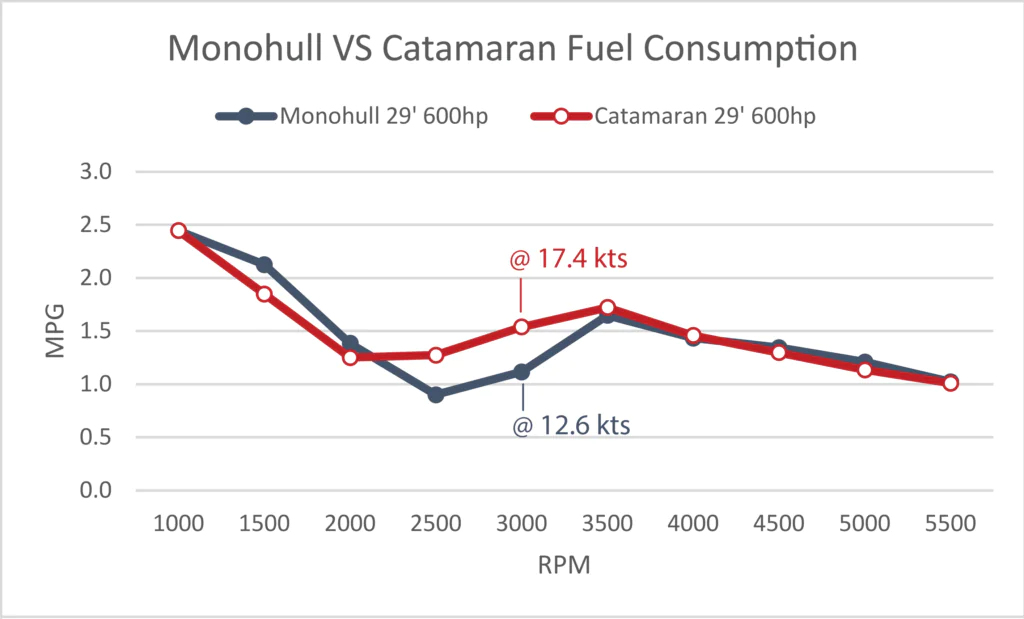
Drastically improved close-quarter maneuvering: A large separation between the port and stbd engine drastically improves close-quarters maneuvering. This enables a power catamaran to literally rotate within its own waterline length by simply putting one engine in reverse, and one in forward. Add a joystick control and you’re in command of one of the easiest boats that you will ever dock.
Disadvantages of Power Catamarans
Despite the significant benefits gained by the power catamaran, there are also a few unusual traits associated with powercats:
Outward banking
Snaking at anchor, tunnel-slap, unusual appearance.
When making sharp turnsm a monohull will bank (roll) into the turn. A catamaran, on the other hand, due to its increased stability and righting moment will actually bank slightly outward. If coming from a monohull background, initially this sensation will feel unusual. However, If you have no prior expectations regarding the outward bank offers ,no benefits or disadvantage over the inward bank.
Due to the power catamarans wide beam and asymmetry, when at anchor a shifting breeze will cause the vessel to turn to port and stbd in a snakelike movement. If the wind has some strength and continues to shift, this movement can become uncomfortable. We therefore recommend attaching an anchor bridle whenever anchoring which completely eradicates this effect.
In certain conditions, catamarans can experience tunnel slap. This is where a wave passing under the tunnel rises up and slaps the wingdeck surface causing a thud or slapping sound. This effects different catamaran designs in various ways depending on whether they are of displacement or planning type. A displacement catamaran requires a high wingdeck to overcome the wave crest heights in order to ride over the top of the waves. Planning catamarans, on the other hand, should have narrower and shallower tunnels. This forces a compressed air mixture through the tunnel, creating a cushioning and lifting effect lifting the catamaran above the surface of the water with intensity increasing as speed increases.
When asked, many monohull owners claim they do not like the unusual appearance of a power catamaran. Whilst styling preference is subjective, at Makai we have worked hard to design a power catamaran that delivers all of the benefits of a catamaran. Whilst doing so with attractive and unmistakable styling.
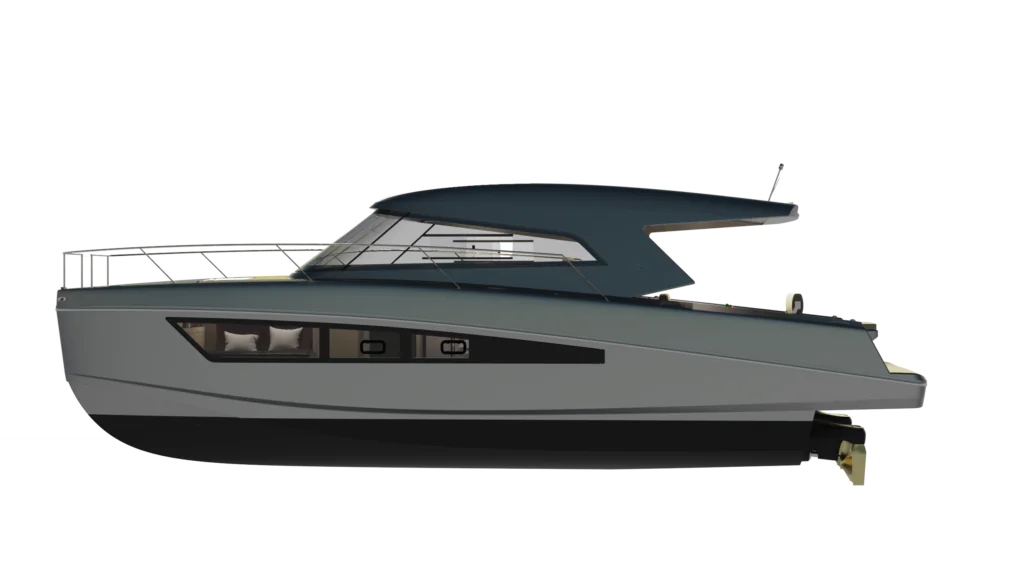
CONCLUSION : Power Catamaran or Monohull?
Whilst each have their own advantages and disadvantages the final choice is completely down to personal preference. Clearly, we are die hard catamaran believers, but we also believe that what is most important above all else is just getting outside and on the water, having fun and being safe. So, when you find the boat that does all of the right things for you, go for it!
Learn more about MAKAI Yachts HERE>>
Learn more about the MAKAI M37 HERE>>
- Get Newsletter
- Privacy Policy
https://calendly.com/makaiyachts/makai-m37-boat-tour?month=2024-08

Catamaran Or Monohull? 27 Important Facts (Explained)
Catamarans and monohull boats are two very different kinds of vessels. Each craft offers distinct advantages and disadvantages that you’ll want to consider before choosing between the two.
In this post, we’ll go over some of the important things to consider when choosing between catamarans and monohull boats:
Table of Contents
Cost & Availability
Both catamarans and monohull boats come in small recreational sailing versions, larger motorboat versions, and larger sailing models. In all cases, the catamarans will cost more and will be harder to find.
The reason catamarans are harder to find because there are not as many of them, and they’re mostly made overseas.
Also, there aren’t as many catamaran manufacturers, so sailors have fewer options when buying them.
On top of this, catamarans have only recently become popular in the United States and other areas of the developed world. This means the used market for boats doesn’t have as many catamarans on it. You might find that you have fewer options when making a used catamaran purchase, which could bring costs up to a premium.
Two Times The Fun with Catamarans

Another reason that catamarans are more expensive than monohulls is the fact that catamaran buyers have to purchase two hulls, two engines, and two of all of the components that help make an engine work.
Traditional sailboats and large powerboats with one engine don’t have this cost issue.
On top of this, a catamaran is much wider than a monohull, and thus you have more space to build and equip.
On the other hand, once you’ve purchased the boat, you do get to enjoy the benefits of having two of everything. We’ll talk about the advantages of this further down in this post.
Maintenance Cost Makes A Difference
The maintenance on a catamaran is also more expensive than the maintenance on a monohull boat. This goes back to the fact that there is twice as much of everything to maintain.
Catamaran owners will need to do preventative maintenance on two different engines, and they’ll have two hulls and a large deck area to clean and maintain as well. If they’re getting the bottom of the boat treated, they’ll have to do this twice (once for each hull).
Even the interior components can usually be found twice.
Each cabin will usually have a head in it, so you’ll have at least two toilets and sinks to maintain, which obviously has its plusses and minuses.
One positive aspect of this is that catamaran owners do have the option of deferring some of their maintenance. For example, if one head is no longer functioning properly, you always have the second one that you can use.
It also adds a bit of safety as well.
This is because while the catamaran does have two engines to maintain, the owner does have power even if one of the engines happens to go down.
Some catamaran owners also like to point out that maintenance may not have to be done as frequently. This is because the engines don’t have to work quite as hard, and other items like additional bathrooms and sinks might only be used half as much.
How Much Space Do You Need?

A catamaran has more space than a monohull. This is because the boat is wider, and it has a much larger deck area. It also has twice as many hulls, so you have more overall space between the two of them.
The additional space is great for people looking to throw parties on their boats.
Most boat owners would agree that the catamaran is usually the party boat of choice at the docks.
Even if you aren’t into throwing parties, the extra space can still be nice for relaxing on the deck or getting a suntan. The wide-open space also makes it easy to use the boat as a fishing platform.
Additionally, you have more space for stuff like surfboards, rafts, and other items that can easily clutter up the deck of a monohull. Even fishing can be easier from a catamaran as the deck provides plenty of space between different anglers.
Catamaran owners also have additional space for carrying fresh water and adding generators and solar panels.
Interior space is generally more plentiful on a catamaran, and luxury catamarans have an easier time fitting large items like washers and dryers inside of them. You can have these on larger monohulls as well, but it will be harder to make them fit than it is in a catamaran.
On the other hand, all of the additional space means the catamaran owner has more space to maintain and clean. Also, all of the additional items that can be brought onto the boat will make it heavier. A heavier boat will use more fuel, and it will travel more slowly.
Living Quarters Vary Between The Two
The living quarters on a catamaran are much different than they are on a monohull. Most people would agree that the berths in a monohull are much more spacious than in a catamaran.
A monohull offers people the opportunity to have a large bed with space on either side to walk around it. This is great for couples who want to get out of bed without waking up their partner.
Catamarans, on the other hand, have the advantage of being able to offer large above-deck salon areas. The galleys, the dining areas, and the living areas can all be above-deck, while the two hulls can provide heads and berths.
Some boat owners say that living in a monohull is akin to living in a basement apartment . Other boat owners prefer the monohull because it brings them closer to the water and gives them the feeling of being at sea.
Privacy Can Be Prioritized On Catamarans
A catamaran offers up many different living areas that people can take advantage of. For example, each hull will typically have its own bathroom and bedroom.
This gives each sleeping area complete privacy from the other.
The living quarters are usually up on the deck, so early risers can wake up and move to these quarters without waking up the others.
The same holds for night owls. A night owl can stay up late without bothering the people who want to retire to their beds earlier.
With two hulls, large catamaran owners can hire a crew and give them their own hull to live in so that there is separation between the cruisers and the crew. This is a wonderful advantage for honeymooners looking to have their own space.
The downside to all of this, of course, is that sometimes a family may not want the additional privacy. For example, a family with small children might not want their children in a different hull than they are.
Additionally, the extra privacy can make it hard for people on the boat to communicate. This could become a big problem in the event of an emergency.
For this reason, it is often recommended that each hull have a radio in it so that the occupants can quickly communicate with each other. Remember, even in inland areas, cell phone reception may not be very good inside the boat hulls.
Recreation In a Monohull vs. a Catamaran
Most sailors agree that sailing a monohull boat is much more exhilarating than sailing a catamaran. Traditional sailboats heel, and sailors get instant feedback while they’re sailing. For the most part, catamarans stay stable, and you don’t get the same feeling with the movement of the wind and the water.
When it comes to monohull powerboats, you have the advantage of being able to pull water skiers, kneeboarders, and tubers with ease, as long as the boat has the power and a planing hull. A power catamaran usually doesn’t have the speed or maneuverability to pull off these recreational opportunities because they are displacement hull designs.
Catamarans excel in more leisurely recreational activities. A catamaran makes a great party deck as well as a great cruising deck. Catamaran owners can comfortably walk around a catamaran without having to worry that the boat might knock them over the next time it decides to heel. This allows boaters to sit and talk with one another comfortably.
A catamaran can also be used as a beaching vessel. This makes it a great platform for people looking to go swimming or fishing around sand bars and other shallow water areas. It also makes it a great boat for sailors looking to sail a larger boat on a river or lake known for having shallow areas.
Swimming and Diving
Swimming and diving off of a catamaran are usually much easier than doing the same from a monohull. The wide stance of the two hulls offers boat designers the option to put in staircases at the back of both hulls.
In between these staircases, some boats will have an additional diving platform and/or a dedicated frame for pieces of equipment and dinghy storage. This makes catamarans great for swimmers, snorkelers, and divers.
On the other hand, modern monohull sailboats can also have good transom stairs for easy access to the dinghy and swimming. Both types of boats can easily travel far out to sea, giving boaters the option of diving in areas that can’t be accessed from beaches and developed areas.
Boat Draft In Shallow Waters
For the uninitiated, the boat’s draft refers to how deep the boat’s hull sits within the water.
A monohull typically sits deep within the water, while a catamaran sits much higher on the water. This is why we stated that a catamaran is good for shallow waters.
The advantage of having a boat that can go into shallow waters isn’t restricted to just recreational activities like swimming and fishing. A boat that can go into shallow water is safer to operate in areas where a boat with a deeper draft might become damaged.
Additionally, a catamaran has more stability on calm waters. This helps make a catamaran more comfortable to relax or sleep on while at anchor or the dock.
The deeper draft of a monohull boat has its advantages as well. A deeper draft provides more stability in rough waters and allows a boat to go further into the sea.
For this reason, many coastal cruisers will prefer catamarans, while many ocean voyagers will prefer monohull boats. In fact, some areas of the Caribbean and the Florida Keys can be off-limits to boats with deep drafts as it simply isn’t safe for the boat to navigate these waters.
This isn’t to say that you can’t navigate these waters in a monohull boat, but you will have to be cautious depending on how deep your monohull’s boat draft is. You wouldn’t have this issue in a catamaran.
Stability On The Sea

A catamaran offers a lot more stability in shallow waters, in calm waters, at the dock, and anchorage. This makes the boat great for cruising and for relaxing in port.
A monohull offers a lot more stability in rough waters.
This makes this boat great for heading out to sea and for navigating vast distances.
Safety Issues To Consider
Both catamarans and monohulls can be built to navigate the waters they were made for safely. This will be determined more by the boat’s category designation rather than the type of boat.
However, each boat deals with unsafe situations in different ways. For instance, a monohull boat is likely to right itself if it is capsized.
This means that even in rough seas, you’re unlikely to find yourself permanently capsized.
The downside to this is that should you become completely swamped from a capsize in a monohull boat, you are much more likely to sink. In fact, if there is a hull breach on a monohull boat, your boat could sink.
Catamarans are said to be unsinkable. This isn’t completely true, but it is very unlikely that a catamaran will sink. Even if a hull is breached, you still have a second hull to keep the catamaran afloat.
However, a catamaran can’t right itself. If you capsize your catamaran, it will stay capsized.
One other safety concern to consider is that a monohull sailboat will heel while a catamaran will not. This increases the chances that someone could fall off the boat or onto the deck in a monohull boat.
Catamarans Are Faster Than Monohull Boats
A catamaran is faster than the average monohull boat.
This is because they face less water resistance, and their narrow hulls don’t have to deal with their own bow waves as a monohull does.
Of course, catamarans aren’t always faster. Old cruising catamarans may not go faster than 8 knots, and modern monohulls can exceed 10 knots.
Monohull boats tend to sail downwind and in choppy seas better than catamarans. This gives them a speed advantage during ocean voyages.
We have a separate post with complete average speeds per type of catemaran . It’s a must read if you are at all concerned about speed!
Fuel Consumption Considerations
Catamarans have two engines to burn fuel, which can drive up fuel costs.
However, a catamaran is lighter on the water, so it usually takes less energy to move a catamaran. This means you’ll end up using less fuel in a catamaran than you would in a monohull.
On top of this, catamarans can decide to use just one engine in low wind areas. This further decreases the amount of fuel that a catamaran consumes.
These rules only apply to calm waters.
A monohull navigates waters with high waves and strong winds much more efficiently than a catamaran. In this case, you’ll use less fuel in a monohull than you would in a catamaran.
Sailing Differences To Notice
Sailing a monohull boat can be exhilarating. These boats can glide through choppy waters, and you get to feel the motion of the boat as the sea rushes by the cockpit and the wind causes you to heel.
This type of sailing also provides instant feedback as you’ll know what you need to do with the sails as you’ll feel what is going on through the boat’s motion.
Sailors all over the world have been using monohull sailboats for years, and you’ll find plenty of outlets for recreational sailing with a monohull sailboat.
Sailing catamarans do not heel like a monohull sailboat.
These boats, therefore, do not provide the sailor with instant feedback. Also, if you incorrectly sail a catamaran, you do risk capsizing the boat more easily.
Training Can Be Quite Hard
Sailing a catamaran and sailing a monohull boat are two different experiences. People looking to sail either should probably get professional training.
Obtaining this training will always be easier with a monohull boat.
This is because monohulls are more popular, so you’ll have more instructors available to you.
Do You (Or Your Friends) Get Seasick?
People who are prone to getting seasick easily might want to consider a catamaran. A catamaran provides much more stability in calm waters, and you get a lot less movement.
On the other hand, people who are not prone to getting seasick might prefer a monohull in choppy waters.
This is because a monohull will deal with deep and choppy waters with high waves much better than a catamaran will.
As a result, a catamarans movement can seem extreme under these types of conditions. People who have never gotten seasick before can end up sick under these conditions.
Here’s a separate article we wrote with everything you should know about seasickness on Catamarans . There are some things you can do and some things you should know!
Docking Is (Usually) Easier With A Monohull Boat
Docking a catamaran can be a difficult endeavor.
This is because catamarans are often too wide to be docked within the slips located in central areas of a marina.
Because of this, they need to be docked at the end of the dock. This leaves them with fewer spots to dock. It also makes docking more expensive.
Catamaran owners traveling through areas that are unlikely to have many catamarans in them may find it difficult to find a dock at all. This is true in areas of the northern Atlantic where monohulls are much more popular than catamarans.
Storage Issues To Consider
Even storing a catamaran can be more difficult. This is because storage facilities often do not have the equipment to get a catamaran out of the water.
The wide width of these boats requires special lifts, and not all boat marinas will have them.
Storage facilities that do get the catamaran out of the water will often charge more money for it. They’ll charge additional fees for taking the catamaran out of the water, and they’ll charge additional fees for the actual storage of the boat as well.
Redundancy And Backup Equipment
We touched upon this earlier, but it is worth repeating that catamarans have many redundancy built into them. This can be a big advantage when it comes to safety.
For example, if one rudder becomes inoperable, the boat can still be steered with the other one. If one engine becomes inoperable, the boat can still be driven with the other one.
In extreme cases, a hull could become damaged, and you could still stay afloat because the other hull will keep the boat safely above water. These safety advantages can save lives and keep people from becoming stranded out at sea.
The primary downside is the maintenance issue that we mentioned earlier. All of these redundant components will need to be maintained. As a result, maintenance costs will be close to twice as expensive in a catamaran.
Cooking Is Easier On Catamarans

Cooking on a catamaran is usually easier than it is on a monohull. The main reason for this is that a catamaran doesn’t heel like a monohull, so you don’t have to worry as much about things falling over.
This not only makes cooking easier, but it makes cooking safer as well.
Additionally, catamaran galleys tend to have more space in them to move around. Also, they are often up on the deck, so you don’t have to climb in and out of the hull with your dinner in hand.
Dinghy Storage
Monohulls and catamarans can both hold dinghies. The larger the boat, the larger the dinghy can be.
However, catamarans have a wide area at the rear of the boat that is perfect for holding dinghies.
This makes getting in and out of the dinghy easier. Also, people can often have larger dinghies on their catamarans because the boat’s stern is so accommodating.
Power Generation Is Easy On A Catamaran
A catamaran has a lot of space for solar panels and wind turbines. Rigid panels can be placed in areas that won’t be walked on, like overtop of the bimini, and flexible panels can be placed in areas where the panels might end up getting stepped on.
The width of a catamaran even gives them more opportunities to put hydro generators into the water.
This means catamarans can generate more power than the average monohull boat can generate.
On the other hand, a monohull usually has less powered items to worry about. Monohulls need less power to operate at full capacity, so you may not need all of the additional space for generating power.
Ventilation Issues To Think About
Some people feel that monohull boats don’t offer enough ventilation. This is especially true in warmer areas of the world.
Catamarans also lack ventilation within their hulls, but fortunately for them, much of the living space is located up on deck. This gives catamarans an edge when it comes to cruising in warm weather.
On the other hand, monohull owners aren’t exposed to the cold winds that you might find up on deck in harsher climates.
This lack of airflow may actually be of benefit in this instance.
Some people find monohulls to be better looking than catamarans and vice versa.
This all comes down to personal preference, so you’ll have to decide for yourself which type of boat has the advantage in this case.
Some people think catamarans are the most elegant thing in the world while others prefer monohull boats as they look more classic.
Resale Value Is An Important Factor
If you read our extensive guide to boat depreciation per boat type , you know that no matter what boat you buy, it will always go down in value. This is just a sad fact of boat ownership that people need to consider before buying a boat.
Many factors go into how much you’ll be able to get for your boat when you resell it. These factors are the condition of the boat, the age of the boat, and the economy in general. For example, people are less likely to want to buy boats during a recession. This is especially true when it comes to smaller boats.
However, one additional factor that catamaran owners need to consider when thinking about resale value is the value of the dollar.
People from the United States don’t have many American catamarans to choose from and will usually need to buy these overseas.
This means that a catamaran will be less expensive to buy when the dollar is strong compared to the Euro and more expensive to buy when the dollar is weaker in comparison. This will affect the used market as well because higher values on new catamarans can help to bring up the value on the used market.
With a monohull boat, you may not have to consider situations like this as there are makers of monohull boats all over the world.
Don’t Let The Length Trick You!
One thought to keep in mind when comparing monohull boats and catamarans is that their different shapes account for different space advantages.
For example, a 40-foot long catamaran will have much more cubic space than a 40-foot long monohull.
Because of this, when comparing boats, you should look at the cubic space rather than the length. In this case, you may be comparing a 48-foot long monohull with a 40-foot long catamaran.
When you compare the two types of boats in this manner, the price differences aren’t quite as large, and the comparison is fairer. It also may make the operating and maintenance costs more similar.
This is an important distinction to make because the length of the boats can trick you!
Consider Trying Both (Before Buying)
Boats can be an expensive purchase, so it makes sense to try them out before you decide to make your purchase.
Rent each type of boat and use it on the types of waters that you intend to cruise on the most.
Try the boat out in different weather conditions as well, and don’t be afraid to do multiple rentals before you make your final choice. The time and money invested into making sure you get the boat you really want will be more than worth it in the end.
Click to share...
Your source for the latest news on yachts, boats and more. Read through our articles to find out how to compare boats and find the right fit for you!
Catamaran vs. Monohull Fishing Boats - Which is Better
Dec 14, 2023
less than a min
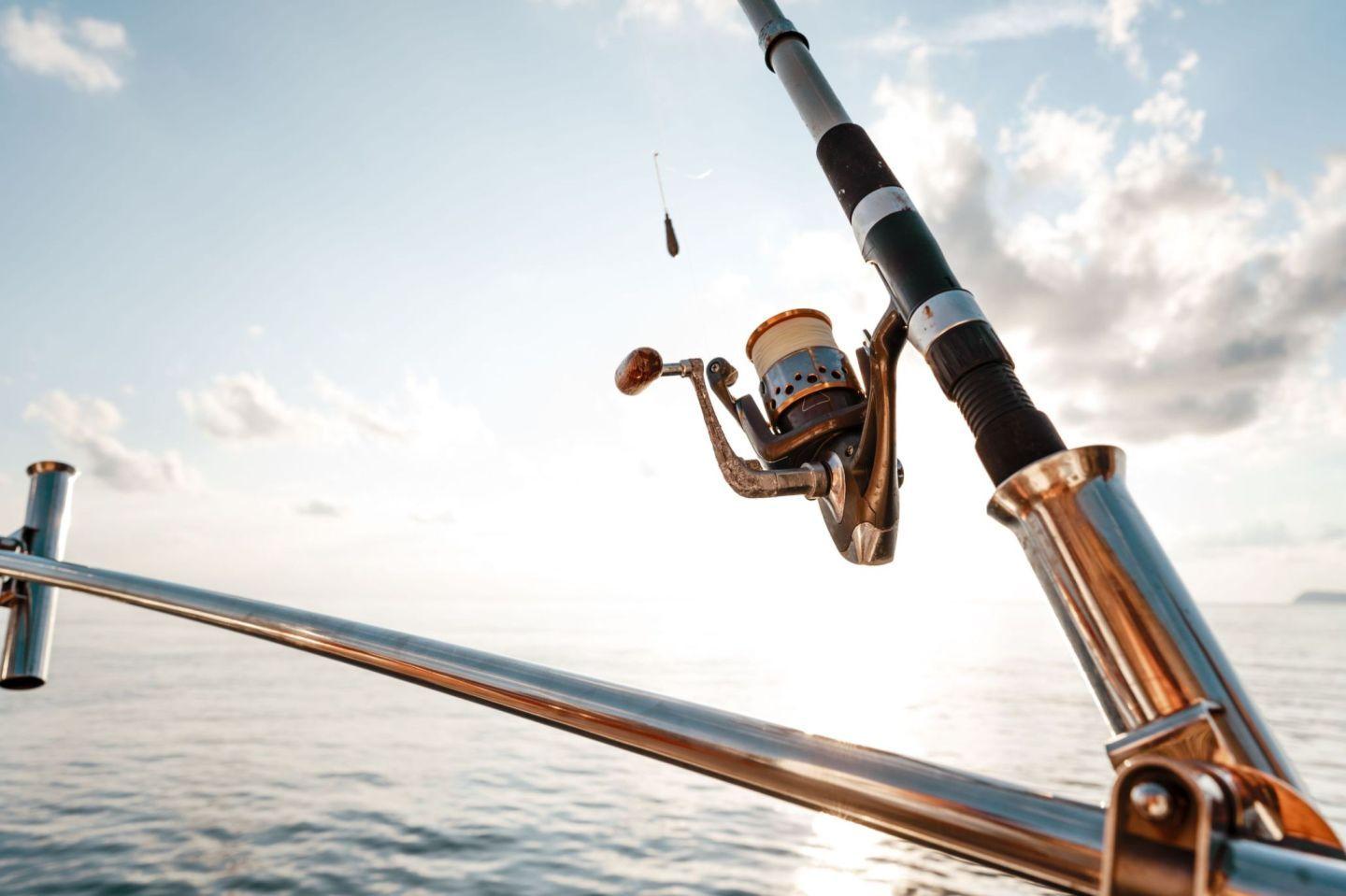
When selecting a fishing boat, anglers face a significant choice that can impact their experience on the water. The type of boat you choose - be it a catamaran or a traditional monohull - plays a pivotal role in defining your fishing adventures. Both catamaran and monohull boats have distinct features and advantages, and understanding these differences is key to finding a vessel that aligns with your fishing style and preferences. Whether you're a seasoned angler or just beginning to navigate the world of fishing, we'll help guide delves into the nuances of catamaran and monohull fishing boats.
Catamaran Fishing Boats: Stability Meets Performance
What are catamaran fishing boats.
Catamaran fishing boats, with their distinctive multihull design, are gaining acclaim among anglers for their exceptional stability and comfort, particularly in challenging sea conditions. The dual-hull structure of these boats not only reduces water resistance, leading to improved fuel efficiency but also ensures a smoother ride. For instance, the "Offshore Fishing Catamarans," which typically range from 20 to 40 feet in length, are equipped with features tailored for serious anglers, including fish boxes, live wells, and rod holders. These boats are adept at handling rough offshore waters, making them ideal for pursuing species like king mackerel or wahoo.
Offshore Fishing Catamarans
Design : Power catamarans , designed for offshore use, are equipped with features like fish boxes, live wells, and rod holders, essential for serious anglers.
Handling Rough Waters : They excel in handling choppy offshore waters, making them suitable for trolling species like king mackerel or wahoo.
Versatility : Not limited to saltwater, they are also effective in large freshwater systems like the Great Lakes.
Comfort for Extended Trips : Many models offer cabins for overnight stays, enhancing their appeal for longer fishing expeditions.
Average Length : 20 to 40 feet
Propulsion : Twin outboard engines
Capacity : 8 to 10 people
Hull Type : Multi-hull
Another notable example is the "Small Fishing Catamaran," averaging between 8 and 14 feet. These smaller variants offer enhanced stability and buoyancy compared to traditional flat-bottom boats and are particularly suitable for shallow water fishing. Their lightweight and easy-to-transport nature, combined with the option for paddle or small outboard motor propulsion, make them a great entry-level choice for new boaters.
Small Fishing Catamaran
Ideal for Beginners : These boats offer an entry-level option with better stability and buoyancy than flat-bottom boats.
Shallow Draft : Their shallow draft allows easy beaching and shore pull-up, ideal for coastal fishing.
Average Length : 8 to 14 feet
Propulsion : Outboard engine or paddle
Capacity : 1 to 3 people
Both types of catamarans exemplify the blend of practical design and angler-centric features, making them a compelling choice for a wide range of fishing activities.
Monohull Fishing Boats: The Traditional Choice
Monohull fishing boats, revered as the traditional choice in the angling world, have long been the backbone of the fishing community. Characterised by their single-hull design, these boats offer a classic approach to fishing, blending time-honoured maritime traditions with modern advancements. Monohulls are known for their straightforward handling and predictable performance, making them a familiar and reliable option for many anglers. Their design allows for deep V-hulls that can cut through waves, offering a smooth ride and a distinct fishing experience.
Advantages of Monohull Fishing Boats
Space Utilisation : Monohulls offer a larger single space below the waterline, allowing for bigger cabins and storage areas.
Roll Period : They have a slower roll period, which means the motion is less abrupt compared to some catamarans.
Predictability : Handling characteristics are more consistent and predictable.
Variety and Resale : There's a broader selection of monohulls available, and they tend to be easier to resell.
Monohull Disadvantages
Stability Issues : They can lean significantly with weight shifts on the deck.
Bowrise and Steering : Monohulls experience noticeable bowrise when coming onto plane and may exhibit bow steering.
Catamaran vs. Monohull: Which is Better for Fishing?
Handling and maneuverability.
Catamarans are highly manoeuvrable due to their dual engines and hulls, offering better control, which is crucial when fishing in tight spots or near structures.
Monohulls have predictable handling, but their performance can vary significantly based on the design and sea conditions.
Space and Amenities
Catamarans provide more living space, making them suitable for extended trips and anglers who prioritise comfort.
Monohulls have more space below the waterline, which can be advantageous for storage and cabin size.
Draft and Accessibility
Catamarans, with their shallow draft, allow access to areas that might be challenging for some monohulls.
Monohulls might have limitations in shallow waters but often perform better in deep sea conditions.
Economy and Maintenance
Catamarans are generally more fuel-efficient, but they may have higher maintenance costs due to their dual systems.
Monohulls are traditionally less expensive to purchase and maintain but might not offer the same fuel efficiency as catamarans.
Tailoring to Your Fishing Style
The decision between a catamaran and a monohull fishing boat should be based on your specific fishing style, preferred locations, and comfort requirements. Catamarans are ideal for anglers seeking stability and comfort in various water conditions, while monohulls are suitable for those who prefer traditional handling and may not require extensive space. Ultimately, the right choice will enhance your fishing experience, ensuring safety, efficiency, and enjoyment on the water. Whether you're drawn to the traditional charm of monohulls or the stability of catamarans, TheBoatDB provides a user-friendly platform to assess each option side-by-side. Visit TheBoatDB to delve deeper into the specifics of each type and discover the boat that perfectly aligns with your fishing style and needs.
You might like these too

Sailboat or Motorboat – Learn the pros and cons
Aug 24, 2022

Which is better a wooden boat or fiberglass boat

Which is the Best Economical Catamaran
Oct 04, 2021

Trimaran Sailboats: Pros and Cons
Sep 22, 2021
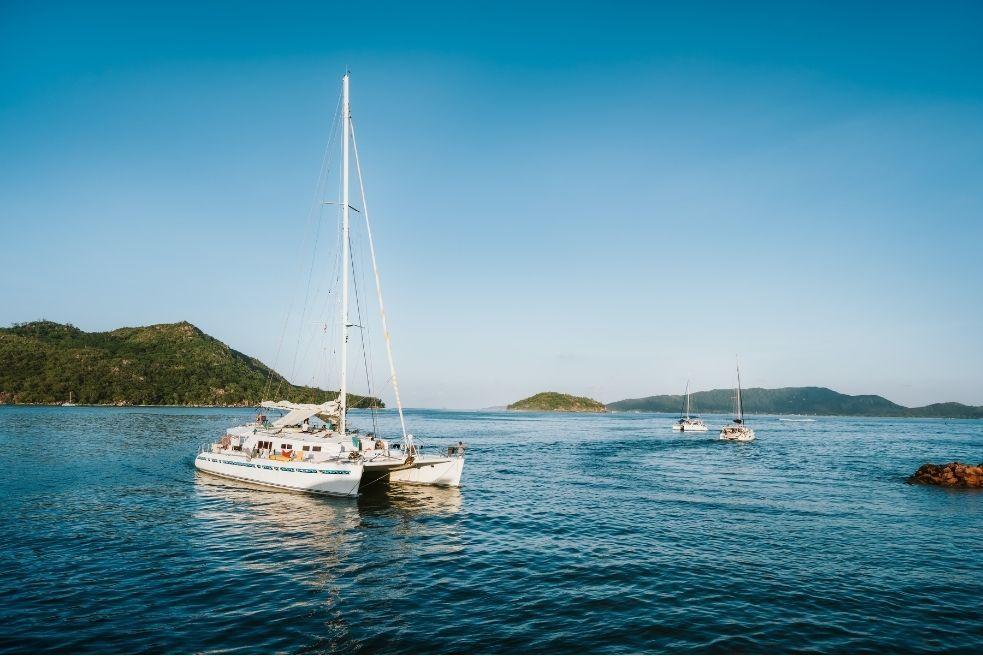
Find Out the Lagoon 42 Catamaran Top Speed
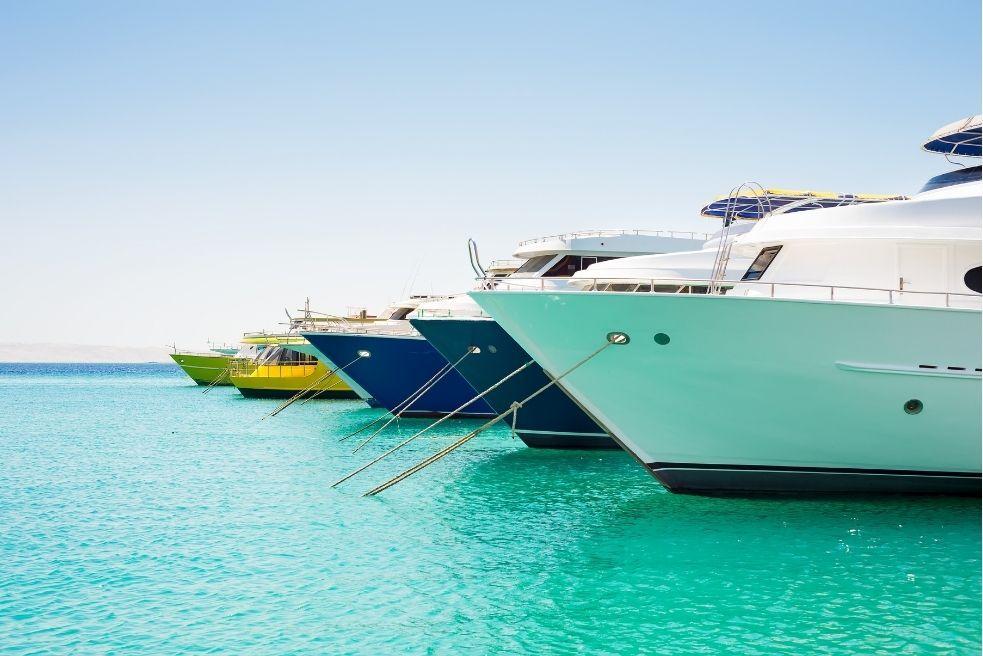
Best Small Boat for Ocean Crossing and Sailing
Sep 16, 2021
- Classifieds
- Remember Me Forgot Password?
- Boats Racing Boats - Electric Discussion What boat should i get? Deep v or catamaran
| (3 min 45 sec) | |
| (1 min 20 sec) |
| |||||||||||||||||||||||||||||||||||||||||||||||||||||||||




IMAGES
VIDEO
COMMENTS
On average, it took the cat 1.15 seconds to reach those Gs, whereas it took the V-hull a little longer at 1.17 seconds. That is, the V-hull accelerated 2 percent slower than the cat. And, as we'll get into later, slower accelerations equal more comfort. The results from the accelerometer confirm our roll period tests.
A V-hull is a mono-hull while a catamaran is a multi-hull consisting of two mono-hulls connected by supporting structure. The two hulls are called sponsons and the space between them is called the tunnel. The underside of the supporting structure is referred to as the wing. Originally, cats were designed to improve a boats lateral stability.
Properly designed, the result is the most efficient hull, inch for inch and horsepower for horsepower, in the go-fast boat world. Where a 50-foot V-bottom from Outerlimits powered by twin 1,350-hp engines from Mercury Racing might run 145 mph, the same-size catamaran from Statement Marine with the same power package might well top 180 mph.
Deep-V Hulls: a wedge-shaped hull from bow to stern. Modified-V Hulls: the most common hull for small boats. Catamarans: two hulls bridged by a deck. Chines and Strakes: molded strips run lengthwise along the hull bottom and are virtually universal on modern planing boats. Above: How your boat's hull is shaped will have a huge impact on how ...
Let's look at the strengths and weaknesses of catamaran and monohull boats. We picked two boats of similar length: the Sea Ray Fly 400 (43 feet 6 inches) and the Leopard 43 Power Cat (42 feet 8 inches). The Sea Ray displaces more (30,900 pounds versus 25,794 pounds), but the major difference is beam: The Leopard, carrying 22 feet 1 inch of ...
Offshore V-Bottom Monohull Speed Boats. The offshore monohull V-bottom is still the quintessential high-performance powerboat. The boat's length dictates the waves you can take on safely and comfortably. Typically, high-performance V-bottom measures from 25 feet and up to over 50 feet.
The best power catamarans ride smoother than comparable monohulls, enjoy an efficiency edge, and also benefit from enhanced stability. But that's just the best ones — there are also plenty of powercats out there which fall short in one way or another. And while each and every boat on the water differs, the safest way to know you're buying one of the best is to choose one built by a top ...
Caught an unplanned side by side comparison of a power catamaran and a V hull Sea Ray leaving Fort Lauderdale on calm water. The power cat is a Robertson & C...
Parvey has never seen how fast his Black Thunder can go. His reason: "Going 150 mph in a V-Hull is not very relaxing." Comparing the two boat types, Parvey said, "There is more room under the deck, a V-Hull is easier to insure, and they are easier to trailer." He can also shower and sleep four comfortably on his boat.
This usually means anyone at the front or sides of the boat takes most of the jostling,"Myers says. "The catamaran-style hull delivers ride comfort, smoothness, load distribution, and stability."That stability draws anglers to powercats of typically 20 to 40 feet; and cruisers to sailing cats 40 to 60 feet and beyond. — Rich Armstrong.
The Bottom Line. For some people power catamarans will prove the better choice, but for others, a V-hull is the way to go. Someone with a bad back, for example, who simply cannot take the constant pounding of running a monohull into a head-sea, will likely be better served by finding a catamaran that can smooth out the blows.
1,661. Dec 10, 2002. #2. Re: Catamaran vs. v-hull? I have always owned deep-V's for use in salt water because that was the best design, UP TO the emergence of the catamaran. The cats ride much smoother in rough water and you can run faster than any other design that I know of in choppy water.
Catamaran Vs V hull power boats. Discussion in 'Boat Design' started by jucasan, Jul 18, 2008. Joined: Jul 2008 Posts: 1 ... working in a school project and would like to know which one is the difference about a race catamaran power boat and a V hull race boat. Don't expect any mathematical explanation, just the basics concepts.
The big v-bottoms are IMO easier to drive in the ocean easier to pick a line and run than a cat. 4. The Cig has a swim step and side ladders to allow you to swim off of the back. Let's face it your not gonna always be running in fact the majority of the time the boat is a means to get somewhere to float and relax. 5.
Silent Yachts 60. Solar panels, ocean-crossing range and self-sufficiency define the electric Silent-Yachts 60 power catamaran. If there was any question that the "Tesla moment" has arrived in yachting, the Silent 60 clearly provides a positive response. Consider, for a moment, crossing oceans in silence at 5 to 6 knots without consuming a drop of fuel and never needing to plan your course ...
The most compelling argument of all must be this: seasoned monohull boaters are converting to catamarans by the truckload. Many converted former motor yacht owners are now passionate advocates of power catamarans. For experienced yachties demanding performance, the advantages are simply too great to ignore. It is rare to hear of any catamaran ...
Backing into a slip is easier on a catamaran than a monohull. To back into a slip (which will make it more convenient for crew to step on and off) pull up until perpendicular with the slip, pivot the boat with the engines and then use both in reverse, adjusting as you back up if there is a beam wind.
For example, most modern power boats with monohulls have a deep V-shape hull that can make them more maneuverable than dual hull catamarans, making them generally easier to dock. Then again, catamarans with modern joystick control systems and smart docking systems can alleviate much of the challenges to close quarter maneuvering.
A catamaran has more space than a monohull. This is because the boat is wider, and it has a much larger deck area. It also has twice as many hulls, so you have more overall space between the two of them. The additional space is great for people looking to throw parties on their boats.
V-Hull to CAT 2024 | Catamaran VS. V Hull 2024 | v hull vs catamaran power boats | FSFTV Welcome to Florida Sport Fishing TV, your ultimate destination for a...
When selecting a fishing boat, anglers face a significant choice that can impact their experience on the water. The type of boat you choose - be it a catamaran or a traditional monohull - plays a pivotal role in defining your fishing adventures. Both catamaran and monohull boats have distinct features and advantages, and understanding these differences is key to finding a vessel that aligns ...
This has been objectively measured (with accelerometers) in a Glacier Bay 26 powercat versus a Regulator 26 monohull—both boats known for providing an excellent ride—to the tune of a .287-second deceleration versus a 0.081 second deceleration, and a three-G force impact versus a four-G force impact when hitting an identical wave head-on.
This is because their powerplants are widely spaced, at either side of the transom. In a monohull, however, the engines are centered along the transom. As a result, the cat can spin and turn on a dime with little effort, while the monohull has much less leverage when the engines are opposed. Monohull Pro: Monohulls are better weight-bearing ...
But if wind is not a factor, the larger cats can handle chop (but not as well as a deep v). Size of the hull is an important factor if your side is on the choppy side-- the larger the hull the better for chop (~30" or more). Another idea is a boat with a flood chamber. If you look at ATR vs. RTR there are some nice options.
Those foils enable the boat's carbon fiber hull to rise 50 cm above the water, clear of waves and wake. The result is a vessel that is smoother and quieter while still offering plenty of space ...
Find more information and images about the boat and contact the seller or search more boats for sale on YachtWorld. ... Power Catamaran. Length. 43ft. Year. 2024. Model. 43. ... Name. Email Phone (optional) Contact Broker. Boat Details. Description. 2024 Freeman 43. Low Hour Quad Mercury 400 V-10 Power. Mercury Factory Warranty Until April 2027 ...